High Seas
Ships, fore and aft,
in fantasy gaming
by Margaret Foy

High Seas
Ships, fore and aft,
in fantasy gaming
by Margaret Foy

<
Here's a list of ships from Dragon 116.
Decks are added in the following order:
(full) upper, orlop, lower, middle
(partial) quarter, forecastle, poop, and poop royal.
| Trireme, aphract = 5,000 gp | Trireme, cataphract = 4,000 gp | Quadrireme = 25,000 gp | Hemiolia = 10,000 gp | Triemiolia = 3000 gp |
| Longship = 30,000 gp | River Galley = 2,000 gp | Boat = 500 gp | - | - |
| Cog = 5,000 gp | Caravel = 13,000 gp | Carrack = 18,000 gp | Galleon = 20,000 gp | - |
| Naval cutter = 15,000 gp | Brig = 30,000 gp | Corvette = 45,000 gp | Frigate = 60,000 gp | SOL IV Rate = 75,000 gp |
| SOL III Rate = 90,000 gp | SOL II Rate = 105,000 gp | SOL I Rate = 120,000 gp | Naval transport = 65,000 gp | - |
| Cutter, small = 3,000 gp | Cutter, medium = 5,000 gp | Sloop, small = 2,000 gp | Sloop, medium = 4,000 gp | Schooner, medium = 7,000 gp |
| Schooner, large = 14,000 gp | Packet = 15,000 gp | Clipper = 100,000 gp | Cargo, small = 25,000 gp | Cargo, medium = 40,000 gp |
| Cargo, large = 55,000 gp | Cargo, transport = 60,000 gp | - | - | - |
Trireme, aphract = 5,000 gp
Trireme, cataphract = 4,000 gp
Quadrireme = 25,000 gp
Hemiolia = 10,000 gp
Tremiolia = 3000 gp
Longship = 30,000 gp
River Galley = 2,000 gp
Boat = 500 gp
Cog = 5,000 gp
Caravel = 13,000 gp
Carrack = 18,000 gp
Galleon = 20,000 gp
Naval cutter = 15,000 gp
Brig = 30,000 gp
Corvette = 45,000 gp
Frigate - 60,000 gp
SOL IV Rate = 75,000 gp
SOL III Rate = 90,000 gp
SOL II Rate = 105,000 gp
SOL I Rate = 120,000 gp
Naval transport = 65,000 gp
Cutter, small = 3,000 gp
Cutter, medium = 5,000 gp
Sloop, small = 2,000 gp
Sloop, medium = 4,000 gp
Schooner, medium = 7,000 gp
Schooner, large = 14,000 gp
Packet = 15,000 gp
Clipper = 100,000 gp
Cargo, small = 25,000 gp
Cargo, medium = 40,000 gp
Cargo, large = 55,000 gp
Cargo, transport = 60,000 gp
>
| Nautical terms and definitions | Ship personnel | Ship types and functions | Mangonels | Table descriptions |
| Additional notes | Inspirational reading | Inspirational listening |
By far, ships have excited the
imagination more than any other form of
transportation. Odysseus, Horatio
Hornblower, Sir Francis Drake, Captains
Ahab, Nemo, Blood, and Bligh; the Beagle,
the Argo, and the Flying Dutchman — the
list of names goes on and on. Ships battle
wind and wave, sea monsters, fate, and
each other, and those aboard run the
gamut from shining hero to basest knave.
Ships have a way of stimulating the
imagination, generating interest in the
high seas and nautical adventure. This
affection is no stronger than in the gaming
hobby, where sailing miniatures and board
games garner attention and reflect this
preoccupation with the Age of Sail. Roleplayers
who are thus afflicted may take
heart. Now, one can satisfy two cravings
at once: the desire for adventure on the
high seas and playing the AD&D®
game.
Much of this article is based upon information
relevant to the Age of Sail up to
the 19th century. However, there is no
reason why an advanced nation of a
fantastic world could not produce ships
much like the ?big sail? craft popular during
that era. Sailing ships should evolve in
magical worlds as they have in our
technological one.
Nautical terms and definitions
Some nautical terms need to be introduced.
For purposes of this article, a galley
is any vessel that is rowed and sailed. A
ship is a sailing vessel, pure and simple.
The rear half of a vessel is the aft, and the
front half is the fore. The fore part is the
bow, and the aft part is the stern. If one is
facing the fore, the left side is port or
larboard, whereas the right is starboard.
In order from fore to aft, the masts on a
sailing ship are called the fore, main, and
mizzen masts; on a two-master, they are
the main and mizzen masts; and, on a
four-master, they are the fore, main, third,
and mizzen masts. A square rig has square
or rectangular sails hanging from the
crosspieces on the masts (the crosspieces
are called yards or yardarms). On a foreand-
aft rig, the sails are shaped like a right
triangle. One apex of the triangle is attached
to the mast and another to a traverse
beam from the lower mast called a
boom. A lateen rig uses very large sails
shaped like a right triangle. The hypotenuse
side of a lateen rig's sail hangs from a
very wide yard, and the sail is loose-footed
-- that is, without a boom at the bottom. A
square rig gives a vessel quite a bit of
power, but requires many sailors to operate.
The fore-and-aft rig requires fewer
sailors and is more maneuverable, but
delivers less power to the ship. The lateen
rig is midway between the two, both in
terms of power and number of sailors
required to handle it. The masts are
braced by sets of heavy cables called the
standing rigging, while the ropes used to
manipulate the sails, yards, and booms are
called the running rigging.
The lowest space inside the ship is the
hold, where the cargo and supplies are
stored. Above the hold is the orlop deck,
where there are more supplies, the
hearth, and the crew?s mess tables; it is
also where the wounded are put during
battle. Above the orlop deck are the lower,
middle, and upper decks. The crew sling
their hammocks on the lower and middle
decks, and on the orlop deck when the
ship is very crowded. Light, medium, and
heavy mangonels (small catapults used at
sea in the 11th and 12th centuries) are
emplaced on the upper, middle, and lower
decks, respectively. Not all vessels have a
full number of decks; very few do.
Aft of the mizzen mast, over the upper
deck, is the quarterdeck, which roofs over
the space where the officers and some
petty officers have their quarters. Fore of
the foremast, over the upper deck, is the
forecastle, where the rest of the petty
officers sleep and mess. Between the two
partial decks, the open area of the upper
deck is called the waist, in which the ship?s
boats are stored. Over the quarterdeck is
the smaller poop, and over that is the even
smaller poop royal.
The medieval ships (cog, carrack, caravel,
galleon) were built high-charged,
meaning that wooden towers were added
to the hull after the ship was finished,
making them top-heavy. Later, these
wooden ?castles? were built as part of the
hull, but the ships had only one or two full
decks. High-charged ships were top heavy
and liable to capsize. Low-charged ships
added full decks, limited the number of
partial decks, and had a deeper draft (the
distance from the waterline to the keel);
thus, their center of gravity was lower.
Ship personnel
At the bottom of a vessel's hierarchy is
the landsman (landswoman, -elf, or what
have you). This landlubber has no nautical
experience at all and requires four to six
months of training to become an ordinary
sailor. An ?ordinary? has no special skills,
but can go aloft in the rigging to handle
the sails, and on a galley he can be trusted
to follow most commands. After a year of
training, about half of the ordinaries become
able-bodied sailors (ABs). ABs can
make repairs and splice ropes, and know
all the knots; in short, they now ?know the
ropes.? On a galley, they are also the lead
rowers, whose actions give the cues to the
ordinary sailors. Mates, or assistants to
petty officers, are ABs who have special
skills. On a galley, the mates are spaced
out among the banks of oarsmen, since
they set the tempo for the other rowers.
The petty officers and their mates are as
follows: The bosun (or boatswain) and the
bosun?s mates are in charge of various odd
supplies and the ship?s daily maintenance.
The master-at-arms has charge of the
ship?s weapons locker, training the crew in
combat and administering discipline. The
sailing master navigates the ship and
teaches navigation to the master?s mates
and the middies. A quartermaster is a very
junior master's mate who takes the wheel
and steers the ship. Midshipmen (middies)
are petty officers in training to become
lieutenants. Middies supervise work parties
of sailors and do anything else a lieutenant
tells them.
The previously mentioned petty officers
are in the chain of command (COC), which
indicates who is to take command of a
ship when the captain is killed or incapacitated.
The proper order of the COC,
descending in rank after the captain, is:
lieutenants, middies, the sailing master,
master?s mates, quartermasters, the bosun,
and finally, the master-at-arms. If the
master-at-arms dies or is incapacitated, the
COC is exhausted and the command is up
for grabs (and so is the vessel, usually).
There are other petty officers and mates
not in the COC: the cooper, sailmaker,
cook, carpenter, purser, and their mates.
All petty officers report to the first lieutenant
except for the sailing master, who
reports directly to the captain. On small
vessels, the petty officers report to the
sailing master or, if there is none, directly
to the captain. Petty officers are sometimes
called warrant officers.
The lowest-ranking commissioned officer
is the lieutenant, the most senior of
whom oversees the daily operations of the
vessel. Lieutenants frequently command
cogs, cutters, or brigs. In rank above a
lieutenant is the commander, usually commanding
a caravel, brig, or corvette. Next
highest is a captain who, for the most part,
commands a carrack, a frigate, or a ship
of-the-line. A commodore is the captain of
his own ship and commands a squadron of
two to eight vessels. The various types of
admirals command larger squadrons or
fleets, but never a vessel. Even an admiral
?s flagship is commanded by its own
captain.
Regardless of actual rank, the person
commanding a vessel is called Captain.
When introductions are used in conversation,
use the following form: Lt. Alex,
commanding the cutter Valiant. Any officer
of the rank of captain who is not in
command of the vessel is referred to by
the title of the rank one step higher than
captain. This courtesy promotion is used
to avoid having more than one person
addressed as Captain aboard a vessel.
Marines have their own officers and
command structure. Their highest officer
reports to the captain of the vessel. Their
use on vessels is twofold. Firstly, they
provide small missile fire from the decks
or fighting tops (the small platforms at the
top of the masts). Secondly, they fight
boarding battles. The crew and petty
officers of the vessel load and fire the
artillery engines.
Large vessels also carry a third group of
auxiliary officers. These are specialists or
spellcasters, and their chief officer reports
to the captain. An officer may also be a
spellcaster.
The system herein can be used with all
the official character classes outlined in
the Player's Handbook and Unearthed
Arcana. The ship?s complement as given in
this article is not an attempt to introduce a
new character class. Middies, quartermasters,
and all the rest are the titles of positions.
If a DM wishes to use the mariner
NPC from DRAGON® Magazine issue #107
("For Sail: One New NPC," by Scott Bennie)
with this article, he should have no problem.
Use the appropriate level of mariner
for each position on the ship, complete
with their special abilities, but ignore the
various effects of crew ability. Vessels?
statistics as given in the mariner NPC
article are not compatible with this article.
If you decide against the use of the mariner
NPC for an entire vessel?s complement,
it is still recommended that the mariner be
used for officers ? especially the sailing
master, master?s mates, and the quartermasters.
A typical ship?s personnel may be assigned
levels as follows: landsman 0, sailor
1, mate 2, petty officer 3, sailing master
and lieutenant 4, commander 5, captain 6,
commodore 7, admiral 8 and higher.
Aboard rowed vessels, the oarsmen are
either zero or 1st level.
Ship types and functions
The earliest European ships built solely
for war were galleys with prows lengthened
to form a ram. The galley that
offered the best combination of speed,
maneuverability, and offensive ability was
the trirene. Its career lasted from the fifth
century B.C. to the fourth century A.D. The
trireme had three banks of oars with one
rower per oar. These galleys were undecked
(aphract). By 300 B.C., triremes were
often cataphract -- that is, decked. A later galley
with a long career was the quadrireme.
The hemiolia was a galley used exclusively
by pirates. The lower bank had 12
oars and the upper 13 (one rower per
oar). The triemiolia, banked and oared as a
trireme, was developed to chase pirates.
Both could be rowed and sailed at the
same time. The hemiolia?s aft six pairs and
he triemiolia?s aft 15 pairs of upper oars
could be quickly shipped and the benches
cleared away. The rowers were then free
to lower and store the sail, unstep the
mast, and arm for a boarding battle. Both
ships were aphract.
Ancient galleys suffered from three
major disadvantages. Their low freeboard
and light construction made them unlikely
to survive a storm in the open sea. They
lacked cargo space; they had little room to
carry water or food, let alone space in
which to cook, and they had little room in
which to sleep. Fortunately, their construction
allowed them to be beached easily.
Another bright spot was that they could be
portaged easily. An ancient galley could be
portaged on rollers by its crew
2 1/3 miles a day. But the greatest disadvantage
tage of the fighting galleys was the crew.
Galley crews had to be highly trained to
work together. The crews were large, and
they had to have a high morale. For the
galleys that relied on ramming to win their
battles, the crews had to be of very high
quality. But the galleys that relied on marines
to win boarding battles could operate
with average or poor crews. The
ancient navies never used slave rowers;
despite Hollywood history, that practice
didn?t arise until the fifteenth century A.D.
In desperate circumstances, even slaves
would be freed if they volunteered.
Aphract galleys used the ramming strategy.
At the beginning of a battle, the galleys
would work up to battle speed and
attempt to ram an opponent straight amidships.
If successful, the rammer would
immediately row backwards to disengage
its ram; otherwise, the ram could be lost.
The crew and marines on the rammed
ship attempt to grapple the rammer to
board and take it. Even if a ship missed in
its attempt to ram, it might succeed in
running along the side of its opponent and
breaking off its oars. This required the
raking galley ship to take in its oars before
the attempt to rake.
Cataphract galleys grappled their opponents;
then the marines fought a boarding
battle. A naval engagement often developed
into a large raft of boarding battles.
Two devices were introduced to assist in
boarding. The corvus was a bridge 36?
long and 4? wide carried upright in the
bow on a swivel mount. The far end had
several spikes on the bottom. When an
enemy galley was close enough, the lines
holding it up were cut, allowing it to fall
and spike itself to the enemy galley. The
harpax was an iron-bound ballista missile
with several lines attached to a winch at
one end and a grappling iron at the other.
The idea was to grapple and winch in an
enemy. Pots of flaming oil were carried at
the end of long poles that extended from
the bow and sides of the galleys.
The drakkar or Viking longship was a
very different sort of vessel. Unlike the
ancient galleys that were built like racing
shells, it had a true keel and was clinker
built (like shingles), giving it strength and
flexibility. The oars were used to row up
rivers and maneuver in tight passages.
Since they had no rams, drakkars fought
each other by boarding battles. River
galleys were used not only on rivers and
lakes, but also in sea ports for patrol.
The cog was a European ship of the 13th
and 14th centuries. The rear castle was
square, and the forecastle was triangular.
Both were raised platforms added to the
structure of the hull. The cog continued
its career in the Mediterranean in a lateenrigged
form for another century.
The caravel was a ship of the 15th to
16th centuries. It averaged 70-100? in
length and was surprisingly seaworthy
and fast. Its low draft made it excellent for
trade without the benefit of ports (and for
smuggling). Both the Nina and the Pinta
were caravels.
The carrack was the first European ship
to carry artillery and guns. Before then,
naval battles were land battles fought on
planks. The carrack?s career lasted from
the 15th to mid-16th centuries. The cog,
caravel, and carrack were all generalpurpose
ships, used as warships, merchantmen,
and pirates.
The galleon was a warship of the 16th
through 17th centuries. Later, it was fourmasted
and carried up to a hundred guns.
It was the final development of the highcharged
ship. The galleon was slow, not
very maneuverable, and prone to capsize
(as were all high-charged ships).
Cutters and brigs were customarily used
in coastal duties to fill out a blockade and
carry mail, dispatches, or official passengers.
The corvette, or sloop-of-war, was
the fastest ship of the time, but it
was not as well armed as the frigate, Corvettes
could be used as convoy escorts, as
squadron ships, and as pursuit ships in
blockades and against smugglers.
One third to half of the navies of the
17th and 18th centuries was composed of
frigates. The frigate was the workhorse of
the navy. It was well armed, maneuverable,
and not as slow as ships-of-the-line.
In fleet battles, frigates sailed to one side
to repeat the admiral?s orders and tow
away heavily damaged ships. Frigates
were also used as fleet scouts, convoy
escorts, blockade and squadron leaders,
and spies against enemy ports.
The largest fighting vessels of the mid-
17th to mid-19th centuries were the shipsof-
the-line, rated first to fourth. First rates
generally stayed in home waters to protect
important sea ports and coastal facili-
ties. Second rates were usually admirals?
flagships. Third and fourth rates were
often assigned to senior captains. These
ships made up the bulk of a fleet, but not
the majority of a navy. They cost a lot.
Naval transports and their commercial
counterparts were slow, unwieldy, and
nearly defenseless. As such, they were
always escorted. Navies used them to
carry troops, horses, supplies, weapons,
and ammunition. Commercial transports
carried bulky and heavy cargoes: grain,
cattle, stone, ore, metal ingots, etc.
Cutters, sloops, and schooners were
used mostly for fishing, trade, and carry
ing passengers. The fastest commercial
ship was the clipper, which carried passengers
and cargo that required great speed.
Passage on a clipper often ran high (500 gp
would be reasonable in AD&D game
terms), and cargo rated up to 25% of the
assessed value for bulky loads. The second
fastest were the packets, which usually
carried passengers or mail. In times of
war, many navies commissioned packets to
carry military mail and dispatches. The
small, medium, and large cargo ships were
generic merchant ships of the 16th to mid-
19th centuries.
The difference between the roles of
warship and merchantman are clear, but
the difference between a pirate, buccaneer,
and privateer can be very blurry. For
our purposes here, a pirate is one who
unlawfully molests, threatens, fires upon,
detains, of harms a vessel or those on it. A
buccaneer is a pirate who does not harass
the ships of one particular nation ? generally
the nation whose ports the buccaneers
are using. Obviously, one country?s buccaneer
is another?s pirate. A privateer is a
ship that has been awarded a letter of
marque by a government. The letter specifies
which ships are fair game and for
what reasons. Governments issue fetters
of marque to harass an enemy?s shipping
in war time and in peacetime to suppress
piracy and smuggling.
Once a privateer has captured a prize, it
must brine or send the captured ship to a
port in the country issuing the letter.
There, a Prize Court determines if the
prize was covered by the letter; if it was,
the ship and its cargo are then auctioned.
The government has the right to buy the
ship for itself before auction. The privateer
keeps 75% of the price and the rest
goes to the government. Naval ships also
go through the same procedure with their
prizes. Historically, the arrangements for
dividing the spoils varied with country,
custom, and ship.
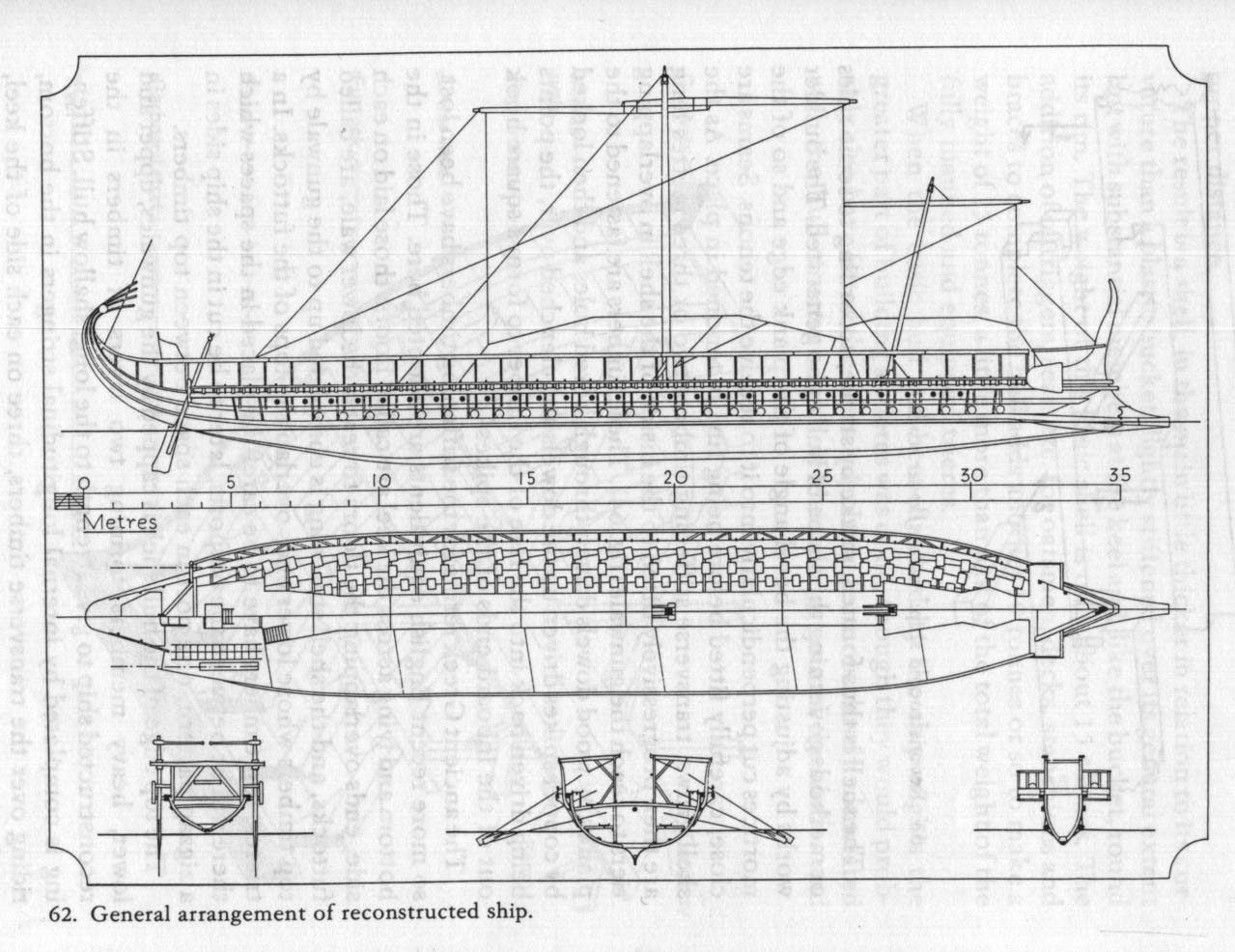
SIZE: M
COST (1,000 gp): 4
FULL LENGTH (ft): 115
DECK LENGTH (ft): 0
BEAM (ft): 12
DRAFT (ft): 3
FREEBOARD (ft): 4
TONNAGE: 50
NO. MASTS: 1
NO. FULL DECKS: 0
NO. PARTIAL DECKS: 0
NO. PUMPS: 0
NO. BOATS: 0
BASE SPEED ("): 9 (3 mph)
MANEUVERABILITY (SAIL): d10 rounds
DEFENSIVE POINTS:
HULL: 24
EACH MAST: 6
RIGGING & SAIL: 4
ARTILLERY ENGINES:
BALLISTAS: 2
LIGHT MANGONELS: 0
MEDIUM MANGONELS: 0
HEAVY MANGONELS: 0
COMPLEMENT:
COMM. OFF.: 1
PETTY OFF. I: 3
PETTY OFF. II: 3
MATES I.: 0
MATES II.: 0
SAILORS: 170
MAXIMUM ADD.: 14
RAM?: Y
OAR LENGTH: 15'
NO. OF BANKS: 3
OARS/BANK:
LOWER: 27
MID: 27
UPPER: 31
TOTAL OARS: 170
ROWERS/OAR: 1
TOTAL ROWERS: 170
OAR SPEED:
NORMAL: 18
BATTLE: 21
SPRINT: 24
MANEUVERABILITY (OARS): d4 rounds
<check type>
The galley that offered the best combination of SPEED, maneuverability,
and offensive capability was the trireme.
It's career lasted from the 5th c. B.C. to the 4th c. A.D.
The trireme had 3 banks of oars with 1 rower per oar.
These galleys were undecked (aphract).
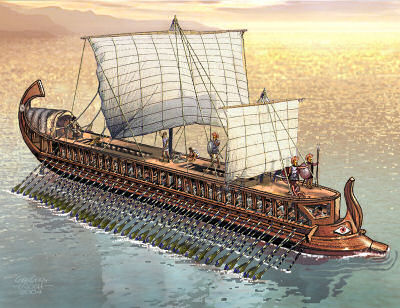
SIZE: M
COST (1,000 gp): 5
FULL LENGTH (ft): 125
DECK LENGTH (ft): 105
BEAM (ft): 13
DRAFT (ft): 4
FREEBOARD (ft): 8
TONNAGE: 65
NO. MASTS: 1
NO. FULL DECKS: 1 (upper)
NO. PARTIAL DECKS: 0
NO. PUMPS: 0
NO. BOATS: 0
BASE SPEED ("): 6 (2 mph)
MANEUVERABILITY (SAIL): d10 rounds
DEFENSIVE POINTS:
HULL: 24
EACH MAST: 8
RIGGING & SAIL: 8
ARTILLERY ENGINES:
BALLISTAS: 4
LIGHT MANGONELS: 0
MEDIUM MANGONELS: 0
HEAVY MANGONELS: 0
COMPLEMENT:
COMM. OFF.: 1
PETTY OFF. I: 3
PETTY OFF. II: 3
MATES I.: 0
MATES II.: 0
SAILORS: 170
MAXIMUM ADD.: 35
RAM?: Y
OAR LENGTH: 17'
NO. OF BANKS: 3
OARS/BANK:
LOWER: 27
MID: 27
UPPER: 31
TOTAL OARS: 170
ROWERS/OAR: 1
TOTAL ROWERS: 170
OAR SPEED:
NORMAL: 15
BATTLE: 18
SPRINT: 21
MANEUVERABILITY (OARS): d6 rounds
By 300 B.C., triremes were often cataphract -- that is, decked.

SIZE: M
COST (1,000 gp): 25
FULL LENGTH (ft): 180
DECK LENGTH (ft): 155
BEAM (ft): 26
DRAFT (ft): 5
FREEBOARD (ft): 10
TONNAGE: 320
NO. MASTS: 1
NO. FULL DECKS: 1 (upper)
NO. PARTIAL DECKS: 0
NO. PUMPS: 0
NO. BOATS: 0
BASE SPEED ("): 6 (2 mph)
MANEUVERABILITY (SAIL): d10 rounds
DEFENSIVE POINTS:
HULL: 36
EACH MAST: 10
RIGGING & SAIL: 12
ARTILLERY ENGINES:
BALLISTAS: 8
LIGHT MANGONELS: 0
MEDIUM MANGONELS: 0
HEAVY MANGONELS: 0
COMPLEMENT:
COMM. OFF.: 1
PETTY OFF. I: 3
PETTY OFF. II: 3
MATES I.: 0
MATES II.: 0
SAILORS: 232
MAXIMUM ADD.: 70
RAM?: Y
OAR LENGTH: 22'
NO. OF BANKS: 2
OARS/BANK:
LOWER: 27
MID: 0
UPPER: 31
TOTAL OARS: 116
ROWERS/OAR: 2
TOTAL ROWERS: 232
OAR SPEED:
NORMAL: 12
BATTLE: 15
SPRINT: 18
MANEUVERABILITY (OARS): d8 rounds
A later galley with a long career was the quadrireme.
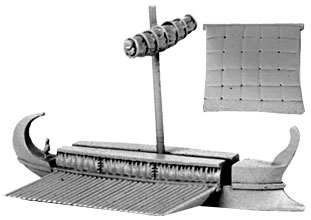
SIZE: S
COST (1,000 gp): 10
FULL LENGTH (ft): 80
DECK LENGTH (ft): 0
BEAM (ft): 10
DRAFT (ft): 3
FREEBOARD (ft): 3
TONNAGE: 25
NO. MASTS: 1
NO. FULL DECKS: 0
NO. PARTIAL DECKS: 0
NO. PUMPS: 0
NO. BOATS: 0
BASE SPEED ("): 9 (3 mph)
MANEUVERABILITY (SAIL): d8 rounds
DEFENSIVE POINTS:
HULL: 16
EACH MAST: 6
RIGGING & SAIL: 6
ARTILLERY ENGINES:
BALLISTAS: 2
LIGHT MANGONELS: 0
MEDIUM MANGONELS: 0
HEAVY MANGONELS: 0
COMPLEMENT:
COMM. OFF.: 1
PETTY OFF. I: 3
PETTY OFF. II: 3
MATES I.: 0
MATES II.: 0
SAILORS: 50
MAXIMUM ADD.: 6
RAM?: N
OAR LENGTH: 12'
NO. OF BANKS: 2
OARS/BANK:
LOWER: 12
MID: 0
UPPER: 13
TOTAL OARS: 50
ROWERS/OAR: 1
TOTAL ROWERS: 50
OAR SPEED:
NORMAL: 18
BATTLE: 21
SPRINT: 24
MANEUVERABILITY (OARS): d6 rounds
The hemiolia was a galley used exclusively by pirates.
The lower bank had 12 oars and the upper 13 (one rower per oar).
SIZE: M
COST (1,000 gp): 3
FULL LENGTH (ft): 90
DECK LENGTH (ft): 0
BEAM (ft): 12
DRAFT (ft): 4
FREEBOARD (ft): 4
TONNAGE: 35
NO. MASTS: 1
NO. FULL DECKS: 0
NO. PARTIAL DECKS: 0
NO. PUMPS: 0
NO. BOATS: 0
BASE SPEED ("): 12 (4 mph)
MANEUVERABILITY (SAIL): d10 rounds
DEFENSIVE POINTS:
HULL: 8
EACH MAST: 8
RIGGING & SAIL: 8
ARTILLERY ENGINES:
BALLISTAS: 2
LIGHT MANGONELS: 0
MEDIUM MANGONELS: 0
HEAVY MANGONELS: 0
COMPLEMENT:
COMM. OFF.: 1
PETTY OFF. I: 3
PETTY OFF. II: 3
MATES I.: 0
MATES II.: 0
SAILORS: 74
MAXIMUM ADD.: 12
RAM?: N
OAR LENGTH: 15'
NO. OF BANKS: 3
OARS/BANK:
LOWER: 12
MID: 12
UPPER: 13
TOTAL OARS: 74
ROWERS/OAR: 1
TOTAL ROWERS: 74
OAR SPEED:
NORMAL: 18
BATTLE: 21
SPRINT: 24
MANEUVERABILITY (OARS): d6 rounds
The triemiolia, banked and oared as a trireme, was developed to chase
pirates.
Both could be rowed and sailed at the same time.
The hemiolia's aft 6 pairs and the triemiolia's aft 15 pairs of uppe
oars could be quickly shipped and the benches cleared away.
The rowers were then free to lower and store the sail,
unstep the mast,
and arm for a boarding battle.
Both ships were aphract.
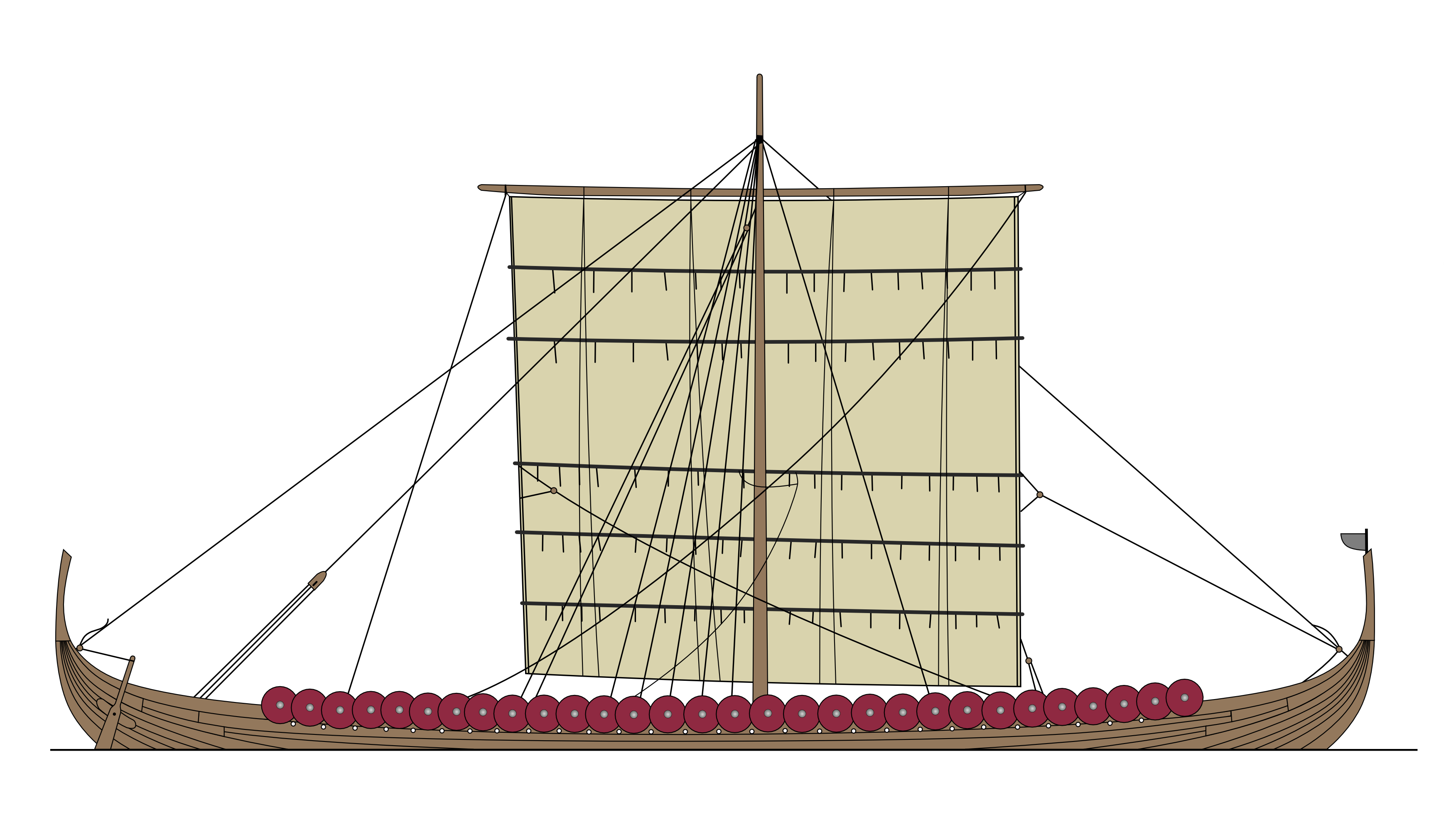
SIZE: L
COST (1,000 gp): 30
FULL LENGTH (ft): 120
DECK LENGTH (ft): 100
BEAM (ft): 27
DRAFT (ft): 8
FREEBOARD (ft): 6
TONNAGE: 425
NO. MASTS: 1
NO. FULL DECKS: 1 (upper)
NO. PARTIAL DECKS: 0
NO. PUMPS: 0
NO. BOATS: 0
BASE SPEED ("): 24 (8 mph)
MANEUVERABILITY (SAIL): d8 rounds
DEFENSIVE POINTS:
HULL: 30
EACH MAST: 15
RIGGING & SAIL: 7
ARTILLERY ENGINES:
BALLISTAS: 0
LIGHT MANGONELS: 0
MEDIUM MANGONELS: 0
HEAVY MANGONELS: 0
COMPLEMENT:
COMM. OFF.: 1
PETTY OFF. I: 1
PETTY OFF. II: 2
MATES I.: 0
MATES II.: 0
SAILORS: 50
MAXIMUM ADD.: 30
RAM?: N
OAR LENGTH: 20'
NO. OF BANKS: 1
OARS/BANK:
LOWER: 25
MID: 0
UPPER: 0
TOTAL OARS: 25
ROWERS/OAR: 2
TOTAL ROWERS: 50
OAR SPEED:
NORMAL: 12
BATTLE: 18
SPRINT: 15
MANEUVERABILITY (OARS): d8 rounds
Longship (93.072)
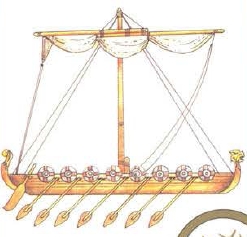
The drakkar or Viking longship was a very different sort of vessel.
Unlike the ancient galleys that were built like racing shells,
it had a true keel and was clinker built (like shingles), giving it
strength and flexibility.
The oars were used to row up rivers and maneuver in tight passages.
Since they had no rams,
drakkars fought each other by boarding battles.
Drakkar
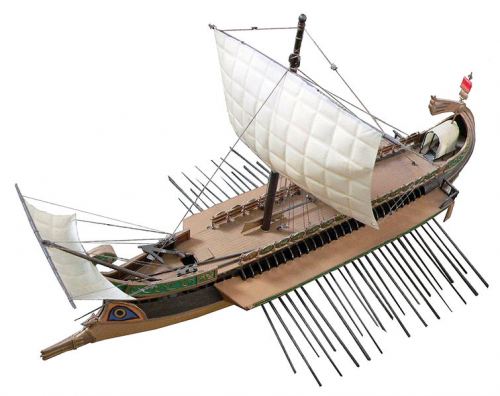
SIZE: S
COST (1,000 gp): 2
FULL LENGTH (ft): 60
DECK LENGTH (ft): 50
BEAM (ft): 15
DRAFT (ft): 5
FREEBOARD (ft): 3
TONNAGE: 50
NO. MASTS: 1
NO. FULL DECKS: 0
NO. PARTIAL DECKS: 0
NO. PUMPS: 2
NO. BOATS: 0
BASE SPEED ("): 15 (5 mph)
MANEUVERABILITY (SAIL): d6 rounds
DEFENSIVE POINTS:
HULL: 12
EACH MAST: 8
RIGGING & SAIL: 4
ARTILLERY ENGINES:
BALLISTAS: 4
LIGHT MANGONELS: 2
MEDIUM MANGONELS: 1
HEAVY MANGONELS: 0
COMPLEMENT:
COMM. OFF.: 1
PETTY OFF. I: 3
PETTY OFF. II: 0
MATES I.: 1
MATES II.: 0
SAILORS: 20
MAXIMUM ADD.:20
RAM?: N
OAR LENGTH: 20'
NO. OF BANKS: 1
OARS/BANK:
LOWER: 13
MID: 0
UPPER: 0
TOTAL OARS: 26
ROWERS/OAR: 2
TOTAL ROWERS: 52
OAR SPEED:
NORMAL: 15
BATTLE: 18
SPRINT: 21
MANEUVERABILITY (OARS): d6 rounds
River galleys were used not only on rivers and lakes,
but also in sea ports for patrol.
BOAT
SIZE: VS
COST (1,000 gp): 1/2
FULL LENGTH (ft): 30
DECK LENGTH (ft): 0
BEAM (ft): 10
DRAFT (ft): 3
FREEBOARD (ft): 2
TONNAGE: 10
NO. MASTS: 1
NO. FULL DECKS: 0
NO. PARTIAL DECKS: 0
NO. PUMPS: 0
NO. BOATS: 0
BASE SPEED ("): 15 (5 mph)
MANEUVERABILITY (SAIL): d4 rounds
DEFENSIVE POINTS:
HULL: 6
EACH MAST: 4
RIGGING & SAIL: 2
ARTILLERY ENGINES:
BALLISTAS: 1
LIGHT MANGONELS: 0
MEDIUM MANGONELS: 0
HEAVY MANGONELS: 0
COMPLEMENT:
COMM. OFF.: 0
PETTY OFF. I: 0
PETTY OFF. II: 0
MATES I.: 0
MATES II.: 0
SAILORS: 16
MAXIMUM ADD.: 16
RAM?: N
OAR LENGTH: 5'
NO. OF BANKS: 1
OARS/BANK:
LOWER: 8
MID: 0
UPPER: 0
TOTAL OARS: 16
ROWERS/OAR: 1
TOTAL ROWERS: 16
OAR SPEED:
NORMAL: 12
BATTLE: 15
SPRINT: 18
MANEUVERABILITY (OARS): d4 rounds
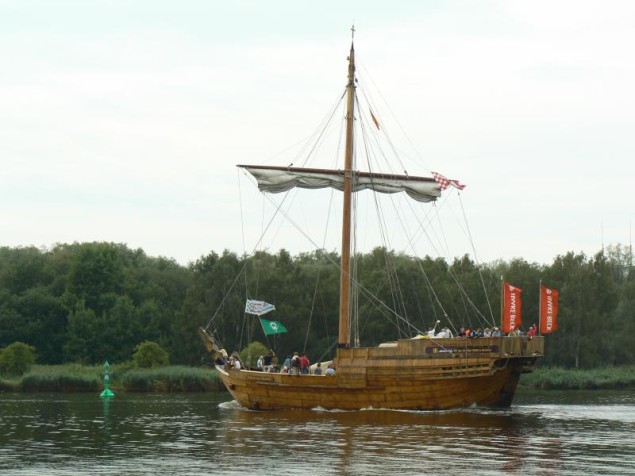
SIZE: M
COST (1,000 gp): 5
FULL LENGTH (ft): 100
DECK LENGTH (ft): 85
BEAM (ft): 20
DRAFT (ft): 10
FREEBOARD (ft): 10
TONNAGE: 150
NO. MASTS: 2
NO. FULL DECKS: 1 (upper)
NO. PARTIAL DECKS: 2 (quarter, forecastle)
NO. PUMPS: 2
NO. BOATS: 2
BASE SPEED ("): 24 (8 mph)
MANEUVERABILITY (SAIL): d10 rounds
DEFENSIVE POINTS:
HULL: 20
EACH MAST: 9
RIGGING & SAIL: 10
ARTILLERY ENGINES:
BALLISTAS: 4
LIGHT MANGONELS: 0
MEDIUM MANGONELS: 0
HEAVY MANGONELS: 0
COMPLEMENT:
COMM. OFF.: 2
PETTY OFF. I: 4
PETTY OFF. II: 5
MATES I.: 2
MATES II.: 0
SAILORS: 20
MAXIMUM ADD.: 130
The cog was a European ship of the 13th to 14th centuries.
The rear castle was square,
and the forecastle was triangular.
Both were raised platforms added to the structure of the hull.
The cog continued its career in the Mediterranean in a lateen-rigged
form for another century.
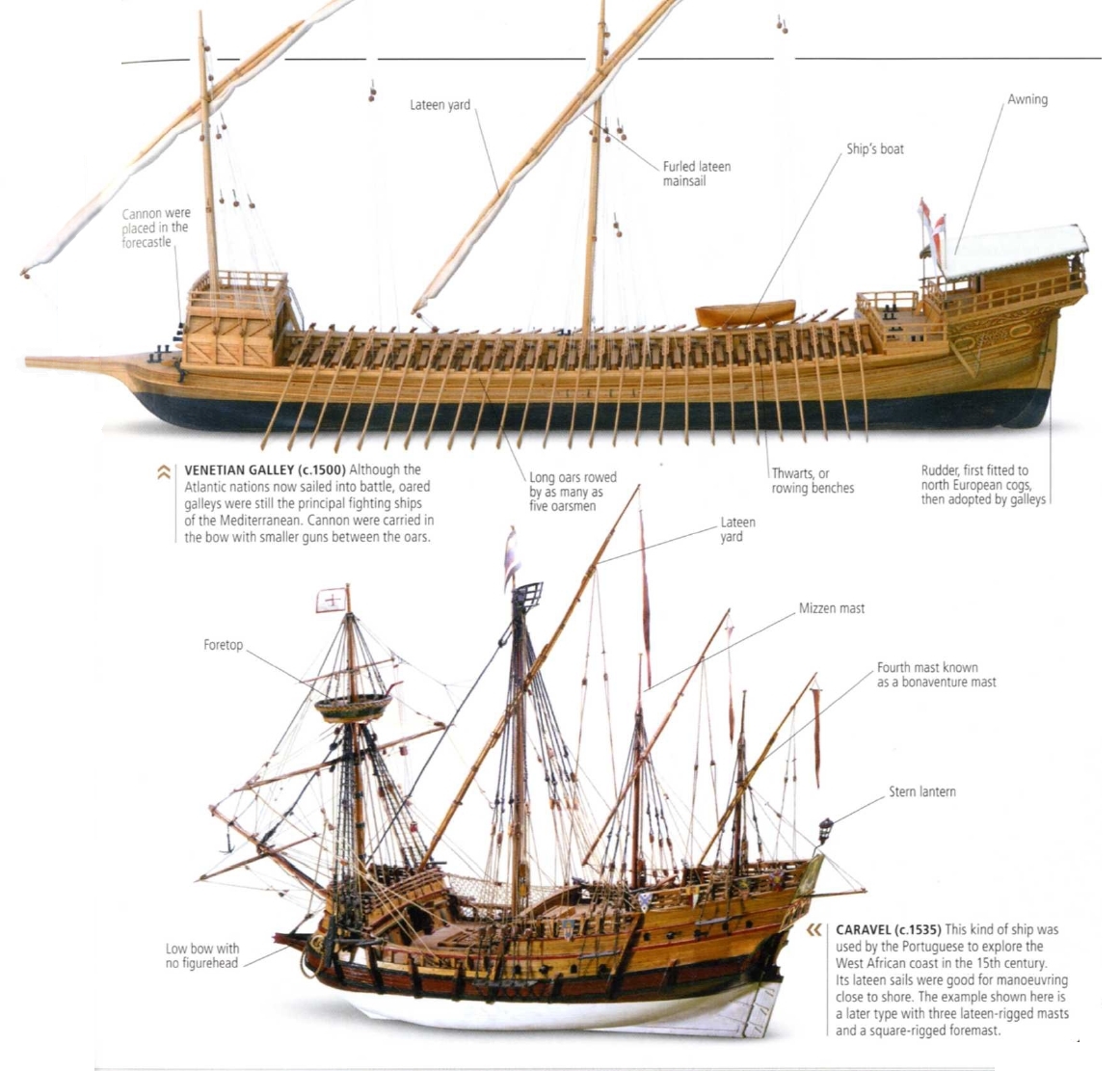
SIZE: M
COST (1,000 gp): 13
FULL LENGTH (ft): 85
DECK LENGTH (ft): 75
BEAM (ft): 20
DRAFT (ft): 7
FREEBOARD (ft): 7
TONNAGE: 100
NO. MASTS: 3
NO. FULL DECKS: 1 (upper)
NO. PARTIAL DECKS: 2 (quarter, forecastle)
NO. PUMPS: 2
NO. BOATS: 2
BASE SPEED ("): 30 (10 mph)
MANEUVERABILITY (SAIL): d10 rounds
DEFENSIVE POINTS:
HULL: 25
EACH MAST: 12
RIGGING & SAIL: 14
ARTILLERY ENGINES:
BALLISTAS: 6
LIGHT MANGONELS: 2
MEDIUM MANGONELS: 0
HEAVY MANGONELS: 0
COMPLEMENT:
COMM. OFF.: 2
PETTY OFF. I: 4
PETTY OFF. II: 5
MATES I.: 3
MATES II.: 2
SAILORS: 35
MAXIMUM ADD.: 120
The caraval was a ship of the 15th to 16th centuries.
It averaged 70-100' in length and was surprisingly seaworthy and fast.
Its low draft made it excellent for trade without the benefit of ports
(and for smuggling).
Both the Nina and the Pinta were caravels.
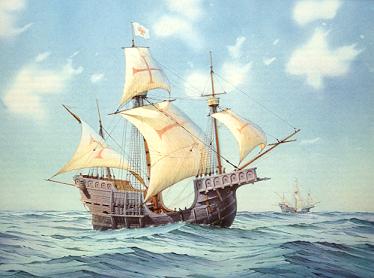
SIZE: L
COST (1,000 gp): 18
FULL LENGTH (ft): 120
DECK LENGTH (ft): 100
BEAM (ft): 20
DRAFT (ft): 11
FREEBOARD (ft): 12
TONNAGE: 685
NO. MASTS: 3
NO. FULL DECKS: 2 (upper, orlop)
NO. PARTIAL DECKS: 2 (quarter, forecastle)
NO. PUMPS: 4
NO. BOATS: 2
BASE SPEED ("): 21 (7 mph)
MANEUVERABILITY (SAIL): d12 rounds
DEFENSIVE POINTS:
HULL: 34
EACH MAST: 10
RIGGING & SAIL: 15
ARTILLERY ENGINES:
BALLISTAS: 8
LIGHT MANGONELS: 2
MEDIUM MANGONELS: 2
HEAVY MANGONELS: 0
COMPLEMENT:
COMM. OFF.: 3
PETTY OFF. I: 6
PETTY OFF. II: 5
MATES I.: 3
MATES II.: 5
SAILORS: 82
MAXIMUM ADD.: 300
The carrack
was the first European ship to carry artillery and guns.
Before then, naval battles were land battles fought on planks.
The carrack's career lasted from the 15th to mid-16th centuries.
The cog,
caravel,
and carrack were all general-purpose ships,
used as warships,
merchantmen,
and pirates
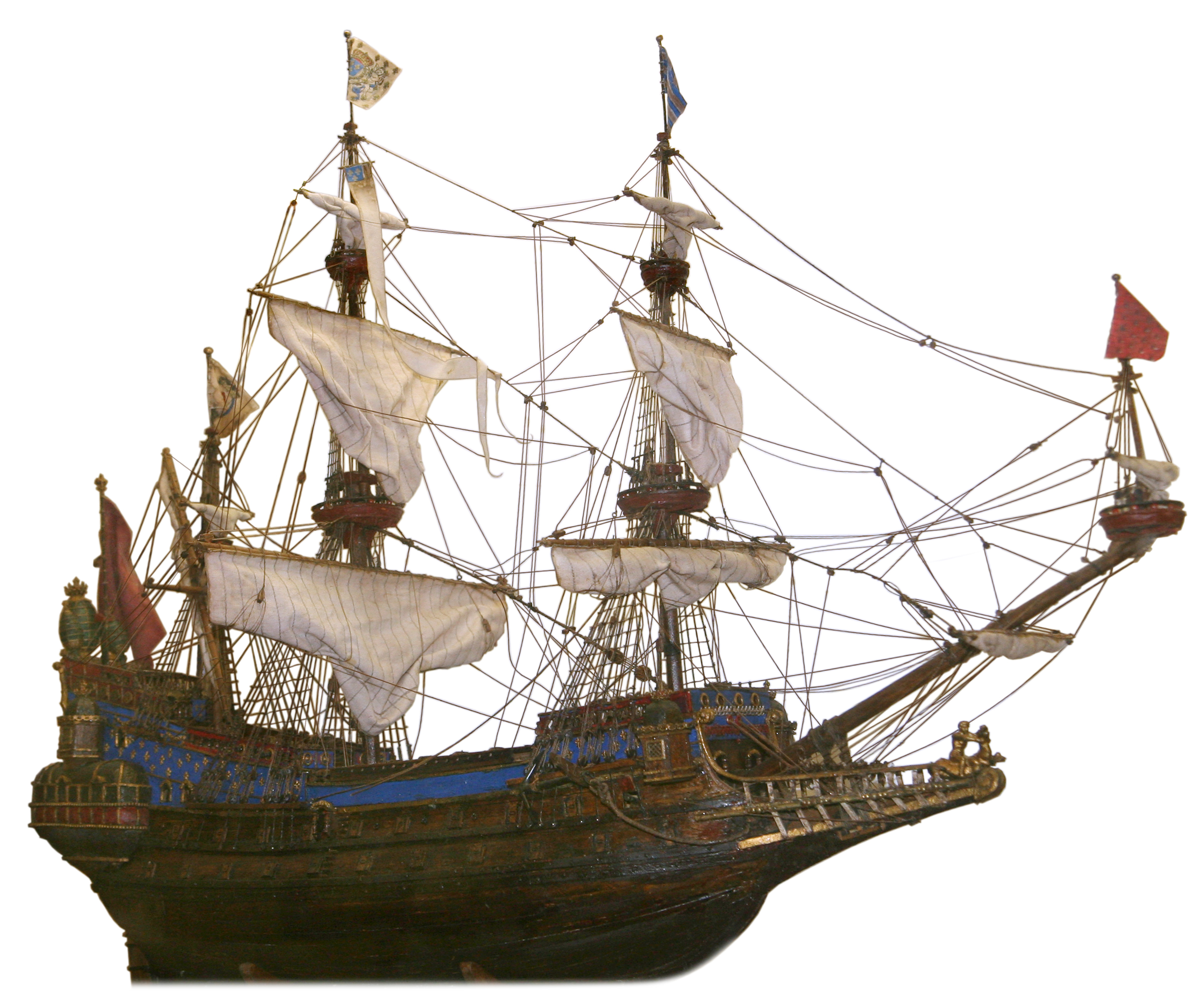
SIZE: L
COST (1,000 gp): 20
FULL LENGTH (ft): 135
DECK LENGTH (ft): 120
BEAM (ft): 35
DRAFT (ft): 17
FREEBOARD (ft): 20
TONNAGE: 1050
NO. MASTS: 3
NO. FULL DECKS: 3 (upper, orlop, lower)
NO. PARTIAL DECKS: 3 (quarter, forecastle, poop)
NO. PUMPS: 5
NO. BOATS: 4
BASE SPEED ("): 18 (6 mph)
MANEUVERABILITY (SAIL): d12 rounds
DEFENSIVE POINTS:
HULL: 34
EACH MAST: 10
RIGGING & SAIL: 15
ARTILLERY ENGINES:
BALLISTAS: 8
LIGHT MANGONELS: 2
MEDIUM MANGONELS: 2
HEAVY MANGONELS: 0
COMPLEMENT:
COMM. OFF.: 3
PETTY OFF. I: 6
PETTY OFF. II: 5
MATES I.: 3
MATES II.: 5
SAILORS: 82
MAXIMUM ADD.: 300
Galleon (93.069)
The galleon was a warship of the 16th through 17th centuries.
Later, it was four-masted and carried up to a hundred guns.
It was the final development of the high-charged ship.
The galleon was slow, not very maneuverable,
and prone to capsize (as were all high-charged ships).
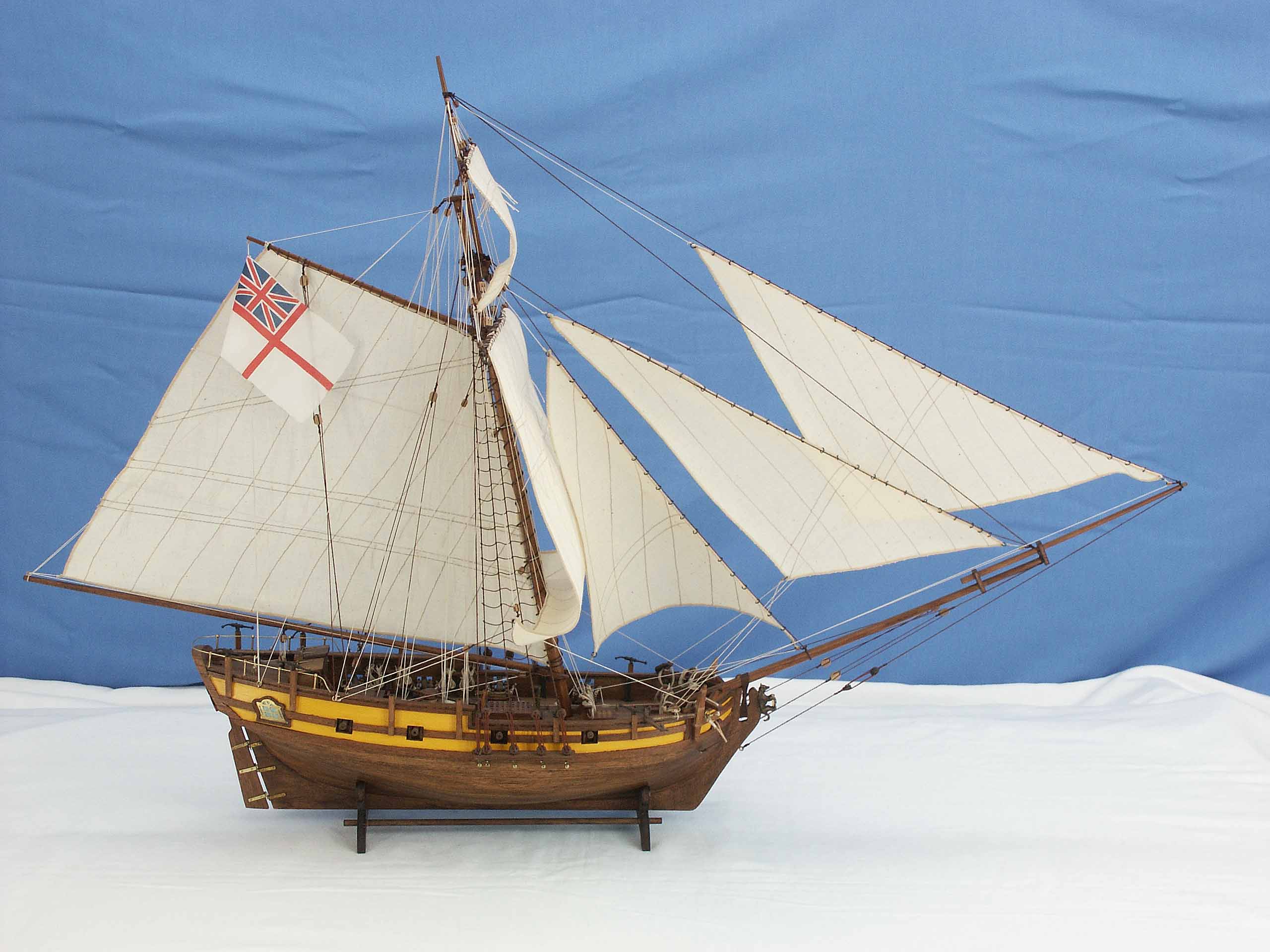
SIZE: M
COST (1,000 gp): 15
FULL LENGTH (ft): 100
DECK LENGTH (ft): 90
BEAM (ft): 22
DRAFT (ft): 6
FREEBOARD (ft): 5
TONNAGE: 190
NO. MASTS: 2
NO. FULL DECKS: 1 (upper)
NO. PARTIAL DECKS: 1 (quarter)
NO. PUMPS: 2
NO. BOATS: 2
BASE SPEED ("): 24 (8 mph)
MANEUVERABILITY (SAIL): d6 rounds
DEFENSIVE POINTS:
HULL: 34
EACH MAST: 10
RIGGING & SAIL: 15
ARTILLERY ENGINES:
BALLISTAS: 8
LIGHT MANGONELS: 2
MEDIUM MANGONELS: 2
HEAVY MANGONELS: 0
COMPLEMENT:
COMM. OFF.: 3
PETTY OFF. I: 6
PETTY OFF. II: 5
MATES I.: 3
MATES II.: 5
SAILORS: 82
MAXIMUM ADD.: 300
Cutters && brigs were customarily used in coastal duties to
1. fill out a blockade and
2. carry mail,
3. dispatches,
4. or official passengers.
<alt>
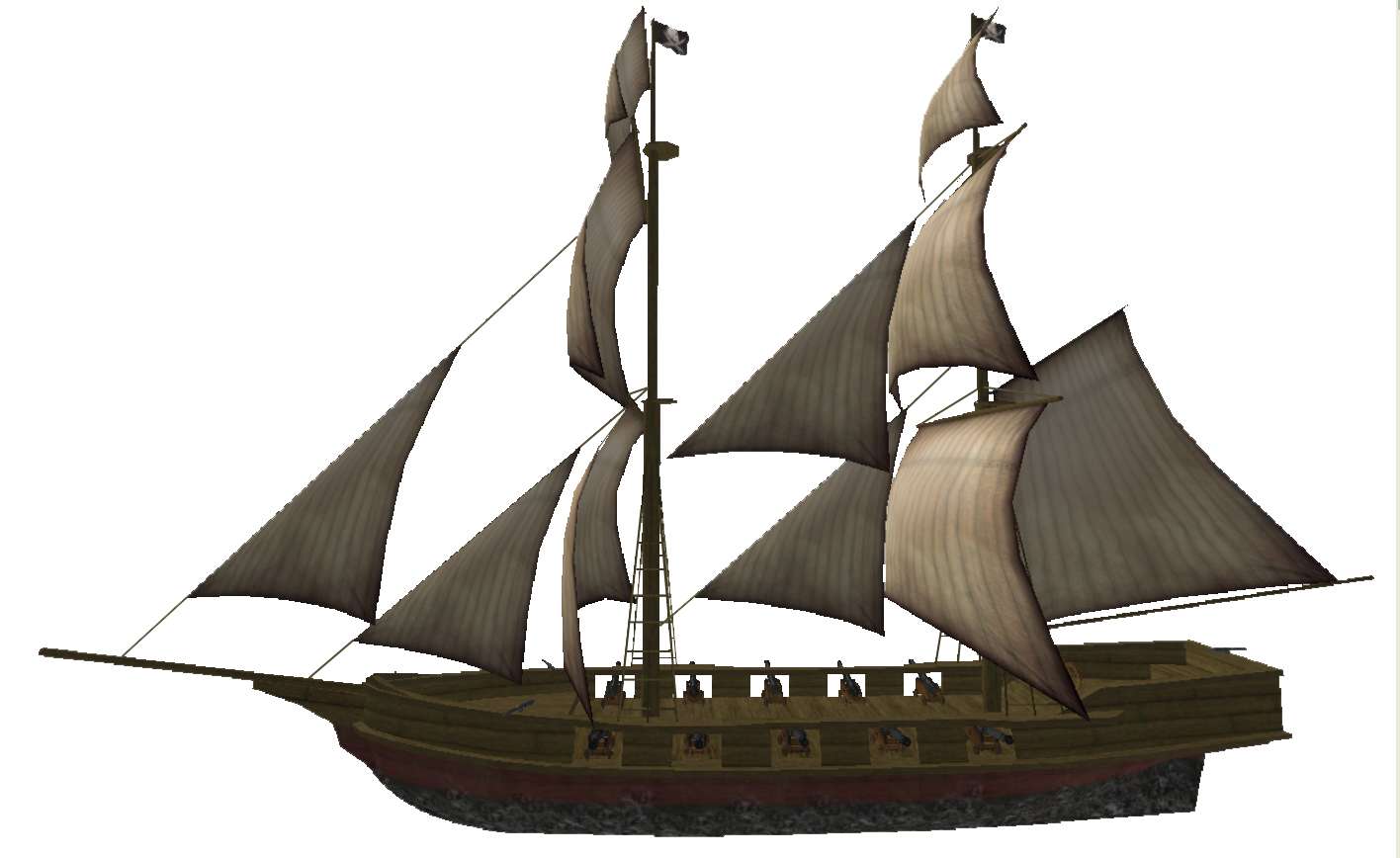
SIZE: M
COST (1,000 gp): 30
FULL LENGTH (ft): 100
DECK LENGTH (ft): 90
BEAM (ft): 25
DRAFT (ft): 10
FREEBOARD (ft): 6
TONNAGE: 250
NO. MASTS: 2
NO. FULL DECKS: 2 (upper, orlop)
NO. PARTIAL DECKS: 2 (quarter, forecastle)
NO. PUMPS: 3
NO. BOATS: 2
BASE SPEED ("): 21 (7 mph)
MANEUVERABILITY (SAIL): d8 rounds
DEFENSIVE POINTS:
HULL: 42
EACH MAST: 10
RIGGING & SAIL: 14
ARTILLERY ENGINES:
BALLISTAS: 12
LIGHT MANGONELS: 16
MEDIUM MANGONELS: 12
HEAVY MANGONELS: 0
COMPLEMENT:
COMM. OFF.: 3
PETTY OFF. I: 7
PETTY OFF. II: 4
MATES I.: 5
MATES II.: 8
SAILORS: 45
MAXIMUM ADD.: 96
Cutters and brigs were customarily used in coastal duties to fill out
a blockade and carry mail,
dispatches,
or official passengers.
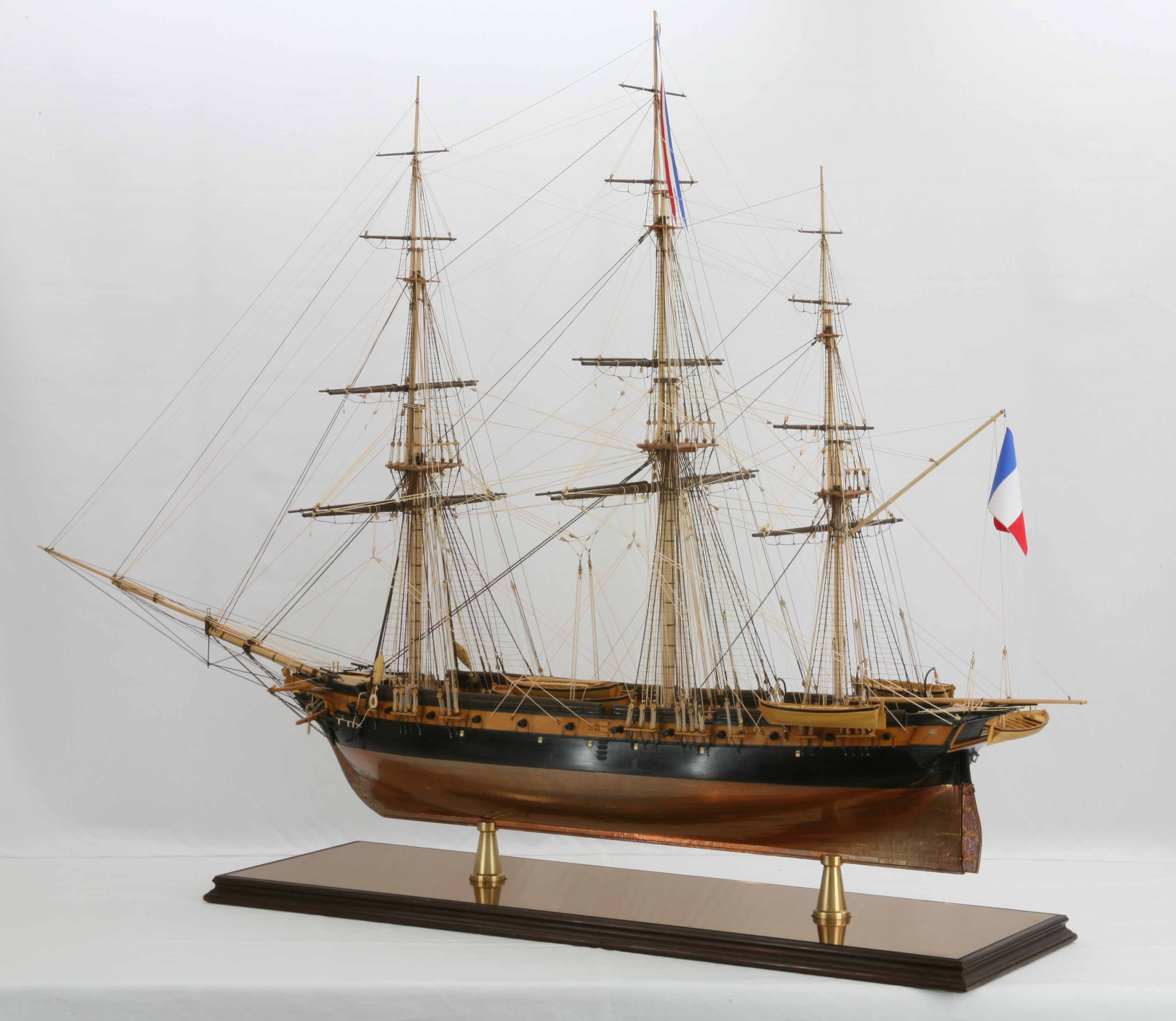
SIZE: M
COST (1,000 gp): 45
FULL LENGTH (ft): 115
DECK LENGTH (ft): 100
BEAM (ft): 25
DRAFT (ft): 10
FREEBOARD (ft): 8
TONNAGE: 270
NO. MASTS: 3
NO. FULL DECKS: 2 (upper, orlop)
NO. PARTIAL DECKS: 1 (quarter)
NO. PUMPS: 3
NO. BOATS: 3
BASE SPEED ("): 30 (10 mph)
MANEUVERABILITY (SAIL): d8 rounds
DEFENSIVE POINTS:
HULL: 51
EACH MAST: 11
RIGGING & SAIL: 18
ARTILLERY ENGINES:
BALLISTAS: 16
LIGHT MANGONELS: 18
MEDIUM MANGONELS: 8
HEAVY MANGONELS: 6
COMPLEMENT:
COMM. OFF.: 4
PETTY OFF. I: 8
PETTY OFF. II: 5
MATES I.: 6
MATES II.: 10
SAILORS: 84
MAXIMUM ADD.: 250
The corvette,
or sloop-of-war,
was the fastest fighting ship of the time,
but it was not as well armed as the frigate.
Corvettes could be used as convoy escorts,
as squadron ships,
and as pursuit ships in blockades and against smugglers.
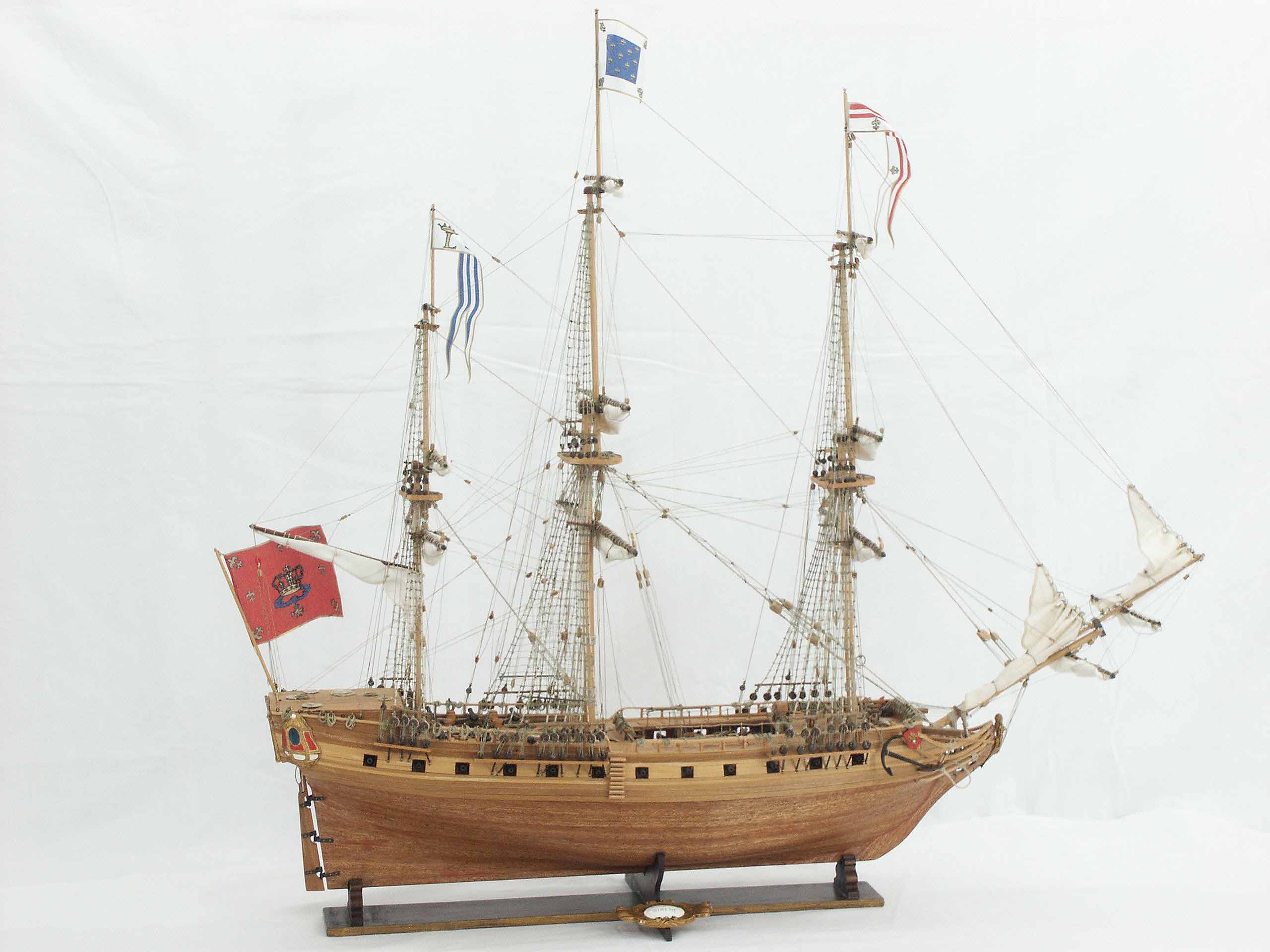
SIZE: L
COST (1,000 gp): 60
FULL LENGTH (ft): 140
DECK LENGTH (ft): 120
BEAM (ft): 34
DRAFT (ft): 15
FREEBOARD (ft): 10
TONNAGE: 610
NO. MASTS: 3
NO. FULL DECKS: 3 (upper, orlop, lower)
NO. PARTIAL DECKS: 2 (quarter, forecastle)
NO. PUMPS: 4
NO. BOATS: 4
BASE SPEED ("): 27 (9 mph)
MANEUVERABILITY (SAIL): d8 rounds
DEFENSIVE POINTS:
HULL: 60
EACH MAST: 13
RIGGING & SAIL: 21
ARTILLERY ENGINES:
BALLISTAS: 16
LIGHT MANGONELS: 20
MEDIUM MANGONELS: 0
HEAVY MANGONELS: 6
COMPLEMENT:
COMM. OFF.: 4
PETTY OFF. I: 11
PETTY OFF. II: 5
MATES I.: 6
MATES II.: 10
SAILORS: 84
MAXIMUM ADD.: 250
1/3 to 1/2 of the navies of the 17th and 18th centuries was composed
of frigates.
The frigate was the workhorse of the navy.
It was well armed,
maneuverable,
and not as slow as ships-of-the-line.
In fleet battles,
frigates sailed to one side to repeat the admiral's orders and two
away heavily damaged ships.
Frigates were also used as fleet scouts,
convoy escorts,
blockade and squadron leaders,
and spies against enemy ports.
SOL IV RATE
SIZE: L
COST (1,000 gp): 75
FULL LENGTH (ft): 160
DECK LENGTH (ft): 140
BEAM (ft): 40
DRAFT (ft): 18
FREEBOARD (ft): 13
TONNAGE: 990
NO. MASTS: 3
NO. FULL DECKS: 3 (upper, orlop, lower)
NO. PARTIAL DECKS: 3 (quarter, forecastle, poop)
NO. PUMPS: 4
NO. BOATS: 5
BASE SPEED ("): 18 (6 mph)
MANEUVERABILITY (SAIL): d10 rounds
DEFENSIVE POINTS:
HULL: 105
EACH MAST: 23
RIGGING & SAIL: 36
ARTILLERY ENGINES:
BALLISTAS: 16
LIGHT MANGONELS: 26
MEDIUM MANGONELS: 22
HEAVY MANGONELS: 18
COMPLEMENT:
COMM. OFF.: 6
PETTY OFF. I: 15
PETTY OFF. II: 5
MATES I.: 9
MATES II.: 15
SAILORS: 72
MAXIMUM ADD.: 250
The largest fighting vessels fo the mid-17th to mid-19th centuries were
the ships-of-the-line,
rated 1st to 4th.
These ships made up the bulk of a fleet, but not the majority of a
navy.
They cost a lot.
3rd and 4th rates were usually assigned to senior captains.
SOL III RATE
SIZE: L
COST (1,000 gp): 90
FULL LENGTH (ft): 180
DECK LENGTH (ft): 160
BEAM (ft): 45
DRAFT (ft): 24
FREEBOARD (ft): 19
TONNAGE: 1460
NO. MASTS: 3
NO. FULL DECKS: 4 (upper, orlop, lower, middle)
NO. PARTIAL DECKS: 3 (quarter, forecastle, poop)
NO. PUMPS: 5
NO. BOATS: 5
BASE SPEED ("): 15 (5 mph)
MANEUVERABILITY (SAIL): d10 rounds
DEFENSIVE POINTS:
HULL: 114
EACH MAST: 25
RIGGING & SAIL: 39
ARTILLERY ENGINES:
BALLISTAS: 16
LIGHT MANGONELS: 28
MEDIUM MANGONELS: 24
HEAVY MANGONELS: 20
COMPLEMENT:
COMM. OFF.: 8
PETTY OFF. I: 19
PETTY OFF. II: 5
MATES I.: 12
MATES II.: 20
SAILORS: 72
MAXIMUM ADD.: 280
3rd and 4th rates were usually assigned to senior captains.
SOL II RATE
SIZE: L
COST (1,000 gp): 105
FULL LENGTH (ft): 200
DECK LENGTH (ft): 180
BEAM (ft): 52
DRAFT (ft): 27
FREEBOARD (ft): 22
TONNAGE: 2100
NO. MASTS: 3
NO. FULL DECKS: 4 (upper, orlop, lower, middle)
NO. PARTIAL DECKS: 4 (quarter, forecastle, poop, poop royal)
NO. PUMPS: 5
NO. BOATS: 6
BASE SPEED ("): 15 (5 mph)
MANEUVERABILITY (SAIL): d10 rounds
DEFENSIVE POINTS:
HULL: 123
EACH MAST: 27
RIGGING & SAIL: 42
ARTILLERY ENGINES:
BALLISTAS: 18
LIGHT MANGONELS: 30
MEDIUM MANGONELS: 26
HEAVY MANGONELS: 22
COMPLEMENT:
COMM. OFF.: 10
PETTY OFF. I: 23
PETTY OFF. II: 5
MATES I.: 15
MATES II.: 25
SAILORS: 72
MAXIMUM ADD.: 290
2nd rates were usually admiral's flagships.
SOL I RATE
SIZE: VL
COST (1,000 gp): 120
FULL LENGTH (ft): 230
DECK LENGTH (ft): 200
BEAM (ft): 57
DRAFT (ft): 30
FREEBOARD (ft): 25
TONNAGE: 2865
NO. MASTS: 3
NO. FULL DECKS: 4 (upper, orlop, lower, middle)
NO. PARTIAL DECKS: 4 (quarter, forecastle, poop, poop royal)
NO. PUMPS: 6
NO. BOATS: 6
BASE SPEED ("): 12 (4 mph)
MANEUVERABILITY (SAIL): d12 rounds
DEFENSIVE POINTS:
HULL: 132
EACH MAST: 29
RIGGING & SAIL: 45
ARTILLERY ENGINES:
BALLISTAS: 18
LIGHT MANGONELS: 32
MEDIUM MANGONELS: 28
HEAVY MANGONELS: 24
COMPLEMENT:
COMM. OFF.: 6
PETTY OFF. I: 15
PETTY OFF. II: 5
MATES I.: 9
MATES II.: 15
SAILORS: 72
MAXIMUM ADD.: 360
1st rates generally stayed in home waters to protect important sea ports and coastal facilities.
NAVAL TRANSPORT
SIZE: VL
COST (1,000 gp): 65
FULL LENGTH (ft): 230
DECK LENGTH (ft): 200
BEAM (ft): 60
DRAFT (ft): 35
FREEBOARD (ft): 20
TONNAGE: 3140
NO. MASTS: 4
NO. FULL DECKS: Variable
NO. PARTIAL DECKS: Variable
NO. PUMPS: 6
NO. BOATS: 3
BASE SPEED ("): 12 (4 mph)
MANEUVERABILITY (SAIL): d12 rounds
DEFENSIVE POINTS:
HULL: 105
EACH MAST: 24
RIGGING & SAIL: 36
ARTILLERY ENGINES:
BALLISTAS: 12
LIGHT MANGONELS: 4
MEDIUM MANGONELS: 4
HEAVY MANGONELS: 4
COMPLEMENT:
COMM. OFF.: 3
PETTY OFF. I: 7
PETTY OFF. II: 5
MATES I.: 5
MATES II.: 10
SAILORS: 40
MAXIMUM ADD.: 1100
Naval transports and their commerical counterparts were slow,
unwieldy,
and nearly defenseless.
As such,
they were always escorted.
Navies used them to carry troops, horses, supplies, weapons, and ammunition.
Commercial transports carried bulky and heavy cargoes:
grain,
cattle,
stone,
ore,
metal ingots, etc.
CUTTER, SMALL
SIZE: S
COST (1,000 gp): 3
FULL LENGTH (ft): 60
DECK LENGTH (ft): 50
BEAM (ft): 14
DRAFT (ft): 10
FREEBOARD (ft): 7
TONNAGE: 40
NO. MASTS: 1
NO. FULL DECKS: 1 (upper)
NO. PARTIAL DECKS: 0
NO. PUMPS: 1
NO. BOATS: 1
BASE SPEED ("): 21 (7 mph)
MANEUVERABILITY (SAIL): d6 rounds
DEFENSIVE POINTS:
HULL: 15
EACH MAST: 8
RIGGING & SAIL: 5
ARTILLERY ENGINES:
BALLISTAS: 2
LIGHT MANGONELS: 0
MEDIUM MANGONELS: 0
HEAVY MANGONELS: 0
COMPLEMENT:
COMM. OFF.: 1
PETTY OFF. I: 4
PETTY OFF. II: 3
MATES I.: 4
MATES II.: 3
SAILORS: 10
MAXIMUM ADD.: 15
Cutters, sloops, and schooners, were mostly used for fishing,
trade, and carrying passengers.
CUTTER, MEDIUM
SIZE: S
COST (1,000 gp): 5
FULL LENGTH (ft): 80
DECK LENGTH (ft): 70
BEAM (ft): 19
DRAFT (ft): 10
FREEBOARD (ft): 7
TONNAGE: 110
NO. MASTS: 2
NO. FULL DECKS: 1 (upper)
NO. PARTIAL DECKS: 0
NO. PUMPS: 2
NO. BOATS: 2
BASE SPEED ("): 21 (7 mph)
MANEUVERABILITY (SAIL): d8 rounds
DEFENSIVE POINTS:
HULL: 20
EACH MAST: 9
RIGGING & SAIL: 10
ARTILLERY ENGINES:
BALLISTAS: 4
LIGHT MANGONELS: 0
MEDIUM MANGONELS: 0
HEAVY MANGONELS: 0
COMPLEMENT:
COMM. OFF.: 1
PETTY OFF. I: 4
PETTY OFF. II: 3
MATES I.: 4
MATES II.: 3
SAILORS: 20
MAXIMUM ADD.: 35
Cutters, sloops, and schooners, were mostly used for fishing,
trade, and carrying passengers.
SLOOP, SMALL
SIZE: S
COST (1,000 gp): 2
FULL LENGTH (ft): 70
DECK LENGTH (ft): 60
BEAM (ft): 16
DRAFT (ft): 10
FREEBOARD (ft): 8
TONNAGE: 65
NO. MASTS: 1
NO. FULL DECKS: 1 (upper)
NO. PARTIAL DECKS: 1 (quarter)
NO. PUMPS: 1
NO. BOATS: 1
BASE SPEED ("): 27 (9 mph)
MANEUVERABILITY (SAIL): d6 rounds
DEFENSIVE POINTS:
HULL: 20
EACH MAST: 10
RIGGING & SAIL: 6
ARTILLERY ENGINES:
BALLISTAS: 4
LIGHT MANGONELS: 0
MEDIUM MANGONELS: 0
HEAVY MANGONELS: 0
COMPLEMENT:
COMM. OFF.: 1
PETTY OFF. I: 4
PETTY OFF. II: 3
MATES I.: 4
MATES II.: 3
SAILORS: 10
MAXIMUM ADD.: 25
Cutters, sloops, and schooners, were mostly used for fishing,
trade, and carrying passengers.
SLOOP, MEDIUM
SIZE: M
COST (1,000 gp): 4
FULL LENGTH (ft): 100
DECK LENGTH (ft): 85
BEAM (ft): 23
DRAFT (ft): 10
FREEBOARD (ft): 8
TONNAGE: 195
NO. MASTS: 2
NO. FULL DECKS: 1 (upper)
NO. PARTIAL DECKS: 1 (quarter)
NO. PUMPS: 2
NO. BOATS: 2
BASE SPEED ("): 27 (9 mph)
MANEUVERABILITY (SAIL): d8 rounds
DEFENSIVE POINTS:
HULL: 30
EACH MAST: 11
RIGGING & SAIL: 12
ARTILLERY ENGINES:
BALLISTAS: 6
LIGHT MANGONELS: 0
MEDIUM MANGONELS: 0
HEAVY MANGONELS: 0
COMPLEMENT:
COMM. OFF.: 1
PETTY OFF. I: 4
PETTY OFF. II: 3
MATES I.: 4
MATES II.: 3
SAILORS: 20
MAXIMUM ADD.: 75
Cutters, sloops, and schooners, were mostly used for fishing,
trade, and carrying passengers.
SCHOONER, MEDIUM
SIZE: M
COST (1,000 gp): 7
FULL LENGTH (ft): 100
DECK LENGTH (ft): 80
BEAM (ft): 22
DRAFT (ft): 10
FREEBOARD (ft): 8
TONNAGE: 190
NO. MASTS: 2
NO. FULL DECKS: 2 (upper, orlop)
NO. PARTIAL DECKS: 1 (quarter)
NO. PUMPS: 2
NO. BOATS: 2
BASE SPEED ("): 24 (8 mph)
MANEUVERABILITY (SAIL): d8 rounds
DEFENSIVE POINTS:
HULL: 25
EACH MAST: 12
RIGGING & SAIL: 14
ARTILLERY ENGINES:
BALLISTAS: 6
LIGHT MANGONELS: 2
MEDIUM MANGONELS: 0
HEAVY MANGONELS: 0
COMPLEMENT:
COMM. OFF.: 2
PETTY OFF. I: 4
PETTY OFF. II: 3
MATES I.: 4
MATES II.: 3
SAILORS: 30
MAXIMUM ADD.: 61
Cutters, sloops, and schooners, were mostly used for fishing,
trade, and carrying passengers.
SCHOONER, LARGE
SIZE: L
COST (1,000 gp): 14
FULL LENGTH (ft): 115
DECK LENGTH (ft): 100
BEAM (ft): 27
DRAFT (ft): 10
FREEBOARD (ft): 8
TONNAGE: 310
NO. MASTS: 3
NO. FULL DECKS: 2 (upper, orlop)
NO. PARTIAL DECKS: 1 (quarter)
NO. PUMPS: 3
NO. BOATS: 3
BASE SPEED ("): 24 (8 mph)
MANEUVERABILITY (SAIL): d10 rounds
DEFENSIVE POINTS:
HULL: 38
EACH MAST: 13
RIGGING & SAIL: 21
ARTILLERY ENGINES:
BALLISTAS: 8
LIGHT MANGONELS: 4
MEDIUM MANGONELS: 2
HEAVY MANGONELS: 0
COMPLEMENT:
COMM. OFF.: 2
PETTY OFF. I: 4
PETTY OFF. II: 3
MATES I.: 4
MATES II.: 3
SAILORS: 30
MAXIMUM ADD.: 100
Cutters, sloops, and schooners, were mostly used for fishing,
trade, and carrying passengers.
SIZE: L
COST (1,000 gp): 50
FULL LENGTH (ft): 140
DECK LENGTH (ft): 120
BEAM (ft): 24
DRAFT (ft): 13
FREEBOARD (ft): 10
TONNAGE: 320
NO. MASTS: 3
NO. FULL DECKS: 2 (upper deck, orlop)
NO. PARTIAL DECKS: 2 (quarter, forecastle)
NO. PUMPS: 3
NO. BOATS: 3
BASE SPEED ("): 33 (11 mph)
MANEUVERABILITY (SAIL): d8 rounds
DEFENSIVE POINTS:
HULL: 60
EACH MAST: 15
RIGGING & SAIL: 24
ARTILLERY ENGINES:
BALLISTAS: 8
LIGHT MANGONELS: 6
MEDIUM MANGONELS: 2
HEAVY MANGONELS: 0
COMPLEMENT:
COMM. OFF.: 3
PETTY OFF. I: 6
PETTY OFF. II: 5
MATES I.: 6
MATES II.: 10
SAILORS: 96
MAXIMUM ADD.: 35
The second fastest were the packets, which usually carried passengers
|| mail.
In times of war, navies commissioned packets to carry military mail
and dispatches.
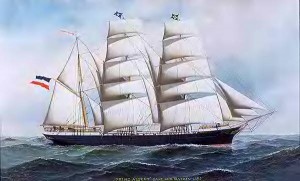
SIZE: VL
COST (1,000 gp): 100
FULL LENGTH (ft): 220
DECK LENGTH (ft): 200
BEAM (ft): 33
DRAFT (ft): 15
FREEBOARD (ft): 5
TONNAGE: 1040
NO. MASTS: 3
NO. FULL DECKS: 2 (upper, orlop)
NO. PARTIAL DECKS: 2 (quarter, forecastle)
NO. PUMPS: 4
NO. BOATS: 4
BASE SPEED ("): 36 (12 mph)
MANEUVERABILITY (SAIL): d10 rounds
DEFENSIVE POINTS:
HULL: 105
EACH MAST: 18
RIGGING & SAIL: 36
ARTILLERY ENGINES:
BALLISTAS: 10
LIGHT MANGONELS: 6
MEDIUM MANGONELS: 2
HEAVY MANGONELS: 0
COMPLEMENT:
COMM. OFF.: 3
PETTY OFF. I: 8
PETTY OFF. II: 5
MATES I.: 8
MATES II.: 12
SAILORS: 108
MAXIMUM ADD.: 220
The fastest commercial ship was the clipper,
which carried passengers and cargo that required great speed.
Passage on a clipper often ran high (500 gp would be reasonable in
AD&D game terms),
and cargo rated up to 25% of the assessed value for bulky loads.
CARGO, SMALL
SIZE: S
COST (1,000 gp): 25
FULL LENGTH (ft): 115
DECK LENGTH (ft): 100
BEAM (ft): 30
DRAFT (ft): 15
FREEBOARD (ft): 10
TONNAGE: 390
NO. MASTS: 3
NO. FULL DECKS: 1 (upper)
NO. PARTIAL DECKS: 1 (quarter)
NO. PUMPS: 2
NO. BOATS: 2
BASE SPEED ("): 21 (7 mph)
MANEUVERABILITY (SAIL): d6 rounds
DEFENSIVE POINTS:
HULL: 33
EACH MAST: 8
RIGGING & SAIL: 15
ARTILLERY ENGINES:
BALLISTAS: 6
LIGHT MANGONELS: 2
MEDIUM MANGONELS: 0
HEAVY MANGONELS: 0
COMPLEMENT:
COMM. OFF.: 1
PETTY OFF. I: 4
PETTY OFF. II: 3
MATES I.: 4
MATES II.: 3
SAILORS: 30
MAXIMUM ADD.: 120
The small, medium, and large cargo ships were generic merchant ships of the 16th to mid-19th centuries.
CARGO, MEDIUM
SIZE: M
COST (1,000 gp): 40
FULL LENGTH (ft): 140
DECK LENGTH (ft): 120
BEAM (ft): 35
DRAFT (ft): 15
FREEBOARD (ft): 10
TONNAGE: 675
NO. MASTS: 3
NO. FULL DECKS: 2 (upper, orlop)
NO. PARTIAL DECKS: 2 (quarter, forecastle)
NO. PUMPS: 3
NO. BOATS: 3
BASE SPEED ("): 18 (6 mph)
MANEUVERABILITY (SAIL): d8 rounds
DEFENSIVE POINTS:
HULL: 39
EACH MAST: 12
RIGGING & SAIL: 21
ARTILLERY ENGINES:
BALLISTAS: 8
LIGHT MANGONELS: 4
MEDIUM MANGONELS: 0
HEAVY MANGONELS: 0
COMPLEMENT:
COMM. OFF.: 2
PETTY OFF. I: 6
PETTY OFF. II: 4
MATES I.: 6
MATES II.: 8
SAILORS: 30
MAXIMUM ADD.: 175
The small, medium, and large cargo ships were generic merchant ships of the 16th to mid-19th centuries.
CARGO, LARGE
SIZE: L
COST (1,000 gp): 55
FULL LENGTH (ft): 170
DECK LENGTH (ft): 150
BEAM (ft): 45
DRAFT (ft): 15
FREEBOARD (ft): 10
TONNAGE: 1325
NO. MASTS: 3
NO. FULL DECKS: 2 (upper, orlop)
NO. PARTIAL DECKS: 3 (quarter, forecastle, poop)
NO. PUMPS: 4
NO. BOATS: 4
BASE SPEED ("): 15 (5 mph)
MANEUVERABILITY (SAIL): d10 rounds
DEFENSIVE POINTS:
HULL: 75
EACH MAST: 16
RIGGING & SAIL: 27
ARTILLERY ENGINES:
BALLISTAS: 10
LIGHT MANGONELS: 6
MEDIUM MANGONELS: 0
HEAVY MANGONELS: 0
COMPLEMENT:
COMM. OFF.: 3
PETTY OFF. I: 8
PETTY OFF. II: 5
MATES I.: 6
MATES II.: 10
SAILORS: 30
MAXIMUM ADD.: 315
The small, medium, and large cargo ships were generic merchant ships of the 16th to mid-19th centuries.
CARGO, TRANSPORT
SIZE: VL
COST (1,000 gp): 60
FULL LENGTH (ft): 200
DECK LENGTH (ft): 175
BEAM (ft): 60
DRAFT (ft): 25
FREEBOARD (ft): 15
TONNAGE: 2660
NO. MASTS: 4
NO. FULL DECKS: Variable
NO. PARTIAL DECKS: Variable
NO. PUMPS: 4
NO. BOATS: 3
BASE SPEED ("): 12 (4 mph)
MANEUVERABILITY (SAIL): d12 rounds
DEFENSIVE POINTS:
HULL: 90
EACH MAST: 20
RIGGING & SAIL: 32
ARTILLERY ENGINES:
BALLISTAS: 12
LIGHT MANGONELS: 6
MEDIUM MANGONELS: 0
HEAVY MANGONELS: 0
COMPLEMENT:
COMM. OFF.: 3
PETTY OFF. I: 8
PETTY OFF. II: 5
MATES I.: 6
MATES II.: 15
SAILORS: 40
MAXIMUM ADD.: 1000
MANGONELS: Mangonels are direct-fire
artillery engines
that use small, round stones or lead shot
for ammunition. They are powered by
torsion, either from twisted thick ropes or
heavy metal springs. Mangonels are used
since arced fire was generally not possible
aboardship. An arced artillery engine
inflicts damage on two targets: the ship
fired upon, and its own rigging and sails.
The stress from a catapult would break a
galley. Mangonels are subject to the same
bonuses and penalties applying to other
artillery engines (see page 109,
DMG).
| Type of Mangonel | Damage, S-M | Damage, M | Crew, min | Crew, max | Range | Field of fire | Rate of Fire |
| Light | 2-16 | 3-12 | 2 | 4 | 1/4" - 30" | 5° | 1/4-1/2 |
| Medium | 3-24 | 4-16 | 4 | 8 | 1/4" - 28" | 5° | 1/4-1/2 |
| Heavy | 4-32 | 5-20 | 6 | 12 | 1/4" - 26" | 5° | 1/4-1/2 |
<prices are not listed: perhaps 75 gp, 100 gp, 125 gp?>
Table Ia <redone>
SIZE:
COST (1,000 gp):
FULL LENGTH (ft):
DECK LENGTH (ft):
BEAM (ft):
DRAFT (ft):
FREEBOARD (ft):
TONNAGE:
NO. MASTS:
NO. FULL DECKS:
NO. PARTIAL DECKS:
NO. PUMPS:
NO. BOATS:
BASE SPEED ("):
MANEUVERABILITY (SAIL):
DEFENSIVE POINTS:
HULL:
EACH MAST:
RIGGING & SAIL:
ARTILLERY ENGINES:
BALLISTAS:
LIGHT MANGONELS:
MEDIUM MANGONELS:
HEAVY MANGONELS:
COMPLEMENT:
COMM. OFF.:
PETTY OFF. I:
PETTY OFF. II:
MATES I.:
MATES II.:
SAILORS:
MAXIMUM ADD.:
| Trireme, aphract = 5,000 gp | Trireme, cataphract = 4,000 gp | Quadrireme = 25,000 gp | Hemiolia = 10,000 gp | Triemiolia = 3000 gp |
| Longship = 30,000 gp | River Galley = 2,000 gp | Boat = 500 gp | - | - |
| Cog = 5,000 gp | Caravel = 13,000 gp | Carrack = 18,000 gp | Galleon = 20,000 gp | - |
| Naval cutter = 15,000 gp | Brig = 30,000 gp | Corvette = 45,000 gp | Frigate = 60,000 gp | SOL IV Rate = 75,000 gp |
| SOL III Rate = 90,000 gp | SOL II Rate = 105,000 gp | SOL I Rate = 120,000 gp | Naval transport = 65,000 gp | - |
| Cutter, small = 3,000 gp | Cutter, medium = 5,000 gp | Sloop, small = 2,000 gp | Sloop, medium = 4,000 gp | Schooner, medium = 7,000 gp |
| Schooner, large = 14,000 gp | Packet = 15,000 gp | Clipper = 100,000 gp | Cargo, small = 25,000 gp | Cargo, medium = 40,000 gp |
| Cargo, large = 55,000 gp | Cargo, transport = 60,000 gp | - | - | - |
Table Ia gives basic information about
each kind of galley and ship. Cost is for a
new vessel of acceptable maintenance
with its masts, yards, rigging, or sails,
but not separate artillery engines, supplies,
or spare parts. Vessels of good maintenance
cost and additional 5%, excellent 15%, and
vessels of advanced design cost an
additional 30%. Thus, an acceptable
corvette costs 45,000 gp; a good one,
47,250 gp; an excellent one, 51,750 gp;
and, one of advanced design, a whopping
58,500 gp.
Full length is from the bowsprit to the
stern (taffrail), while deck length is
measured on the uppermost full deck.
Beam is the width of the vessel, and
(middlemost) deck width is 2-3? less. Draft
is the depth of the keel below the water.
Freeboard is the distance from the
uppermost full deck to the water; in
galleys, this distance is measured from the
lowest oarlock. Both draft and freeboard
are given for a vessel at its max. tonnage,
which is how much weight a
vessel can carry safely beyond the weight
of itself, its masts, sails, rigging, and yards.
If the vessel operates in fresh water,
subtract 5% of tonnage since fresh water
is less buoyant than salt water. Decks are
added in the following order: (full) upper,
orlop, lower, middle, (partial) quarter,
forecastle, poop, and poop royal.
Galleys and ships may MOVE in one of
five directions in relation to the wind in
which they can sail -- four of these are for
both port and starboard (e.g. port tack
and starboard tack). The base speeds of
the vessels may be adjusted by various
factors. Vessels can sail at less than their
calculated actual SPEED; this is simply
a matter of spilling wind from the sails or of
reducing the amount of sail set. On the
open sea, ocean vessels sail all day and
all night long. In AD&D game terms,
a mile is 176? long; thus, 3? is roughly <check this, and add to
the distance chapter in the PH if correct>
equivalent to 1 MPH. Ships tacking on the
open sea or ocean sail for several hours on
one tack before switching. All movement
can bediagrammed easily on hex paper,
with 1 hex = 30 yards (1?).
The numbers under maneuverability
refer to which type of dice are rolled to
determine how many rounds, plus or
minus adjustments (See Tables II and III), it
takes to change from one point of sail to
another. This reflects time spent adjusting
the sails, yards, and rigging. When
maneuvering from one tack to another,
the adjusted roll is tripled.
Table Ib is concerned with the fighting
ability of the ships. The numbers given for
defensive points can be adjusted by plus
or minus 1-10% to allow for some
variation within each type of ship. The
emplacement of mangonels was mentioned
above. Ballistas <[sic]> are mounted on the
partial decks or on the upper deck, if there
are no partials. The ship's
complement is broken down into several
groups. Commissioned officers are lieutenants
and higher. Petty officers and mates (group I)
are in the COC. No ship
has more than one of each petty officer in
group I except middies. Petty officers and
mates of group II are not in the chain of
command. Sailors are able-bodied, ordinary,
and landsmen.
The prevailing practice on a ship is to
divide the complement into two watches.
Each watch stands three shifts on, then
three shifts off. A day is divided into five
four-hour shifts and two two-hour shifts
(the dog watches). Half of the normal
complement is necessary to sail the ship;
in combat, the off-duty watch handles the
artillery engines, makes repairs, and puts
out fires.
Max. additional complement tells how
many marines, auxilliaries, additional
sailors, or officers a ship can carry. On
commercial transports, the additional
complements are passengers (troops on
naval transports). In both instances, the
transports have four full decks.
Table Ic gives additional stats for galleys.
A bank is a line of oars extending from fore to aft.
Normal oar speed can be maintained for up to four hours.
Battle speed can be maintained for 60 rounds,
and sprint speed for only 30 rounds.
All require one hour of complete rest
after the max. time is expended.
Every round of battle SPEED is equivalent
to four rounds at normal SPEED; each round
of sprinting is =equal= to eight rounds
of normal SPEED. The rowed speeds
are for any direction; if you are using hex
paper, you may confine galleys to the six
cross-face directions. A galley must travel
a certain number of rounds on one course
before it can take another. This is listed on
the table as maneuverability (oar). It is
affected by the level of crew ability (see
the diagram on page 15).
Table II: Ship's maintenance and effects
| - | Very poor | Poor | Acceptable | Good | Excellent | Advanced design |
| Naval | 1-5 | 6-10 | 11-40 | 41-80 | 81-97 | 98-00 |
| Pirate/Buccaneer | 1-20 | 21-40 | 41-60 | 61-80 | 81-98 | 99-00 |
| Privateer | 1-10 | 11-20 | 21-46 | 47-72 | 73-98 | 99-00 |
| Commercial | 1-15 | 16-30 | 31-55 | 56-85 | 86-95 | 96-00 |
| Effect on speed | -15% | -10% | -5% | - | +5% | +10% |
| Effect on def. points | -10% | -5% | - | - | +5% | +10% |
| Effect on maneuverability | +2 | +1 | - | - | -1 | -2 |
| Effect on chance of storm damage | +20% | +10% | - | - | -5% | -15% |
Table II randomly assigns the level of a
ship's maintenance and gives the effects
of the resulting level. Adjustments to defensive
points are made to each type. The
chance of storm damage is to be used with
Table IV. The level of maintenance
may be improved by one category (poor to acceptable for instance)
for every two weeks in
dry dock beyond the normal maintenance.
Normal maintenance consists of dry
docking the ship for one week every six
months and an additional two months at
the end of every three years. Failure to do
so lowers the level of maintenance by one
place immediately, and one place further
every six months thereafter. Only a ship
built with advanced design features can be
returned to that level. Dry docking costs
2% of the ship?s value per week. Ancient
galleys are exempt from the usual need
for maintenance in dry dock, since they
are out of the water so much. Dry docking
allows other vessels to have barnacles and
weeds scraped from their bottoms.
Table III: Crew Ability & effects
| - | Very poor | Poor | Acceptable | Good | Excellent |
| Naval | 1-5 | 6-10 | 11-70 | 71-90 | 91-00 |
| Pirate/Buccaneer | 1-15 | 6-30 | 31-90 | 91-98 | 99-00 |
| Privateer | 1-5 | 6-15 | 16-80 | 81-90 | 91-00 |
| Commercial | 1-5 | 6-15 | 16-80 | 81-95 | 96-00 |
| Landsmen | 85% | 70% | 55% | 40% | 20% |
| Ordinary sailors | 10% | 20% | 30% | 40% | 50% |
| Able-bodied sailors | 5% | 10% | 15% | 20% | 30% |
| Effect on "to hit" scores (artillery only) | -2 | -1 | - | - | +1 |
| Effect on maneuverability | +2 | +1 | - | -1 | -2 |
| Base chance to go in irons* | 20% | 10% | 5% | 2% | 1% |
* Check "in irons" chance when changing points of sail,
when careening (for turning turtle), or when a ship is hit by a
sudden natural gust or squall. Triple this chance when
changing tack.
Table III gives the crew's overall rating,
the proportions of able-bodied, ordinary,
and landsmen sailors, and the effects this
has. A galley crew must roll twice to find
out what its rating is as a sailing crew and
as a rowing crew. Use one or the other
rating to determine the effects. The "to
hit" adjustment applies only to artillery
engines. The adjustment to maneuverability
is made to the rolls indicated on Tables
Ia and Ic. No roll can be reduced below 1.
Whenever a ship goes from one POS to
another (as shown in Table IV), the base
chance for the ship to go in irons is rolled.
This out-of-control condition lasts 5-30
rounds. Either indicates the sails were not
set properly or it means poor synchronization
of the oars.
Good officers improve crew quality
through training, good discipline, and fair
treatment. Landsmen take three months
to rise to ordinary, an ordinary sailor takes
one year to rise to able-bodied, and an
able-bodied sailor requires one year further
to rise to mate. Not all ordinary sailors
can rise to ABs, nor can all ABs rise to
mate. Only half of those trained are able
to progress to the next level of ability.
Table IV: Wind
and its effects
Possible points of sailing (POS)
| Beaufort wind force | Name | Wind
speed (MPH) |
Effect
on sailing speed |
% Chance
of storm damage |
Tacking | Reaching | Broad
reaching |
Running
free |
Running
bfr. wind |
| 0 | Calm | 0 | 0 | - | - | - | - | ||
| 1 | Lt. Air | 1-3 | 1/4 | - | - | - | - | ||
| 2 | Lt. breeze | 4-7 | 1/2 | - | - | - | + | ||
| 3 | Gentle breeze | 8-12 | 3/4 | - | + | + | + | ||
| 4 | Mod. breeze | 13-18 | Full | - | + | + | + | ||
| 5 | Fresh breeze | 19-24 | Full | - | + | + | + | ||
| 6 | Str. breeze | 25-31 | +5% | - | + | + | + | ||
| 7 | Fresh gale | 32-38 | +10% | 5 | + | + | + | ||
| 8 | Gale | 39-46 | +15% | 10 | + | + | + | ||
| 9 | Strong gale | 47-54 | +20% | 20 | - | + | + | ||
| 10 | Storm | 55-63 | +25% | 30 | - | - | + | ||
| 11 | Storm | 64-72 | +30% | 40 | - | - | |||
| 12 | Hurricane | 73-82 | +35% | 50 | - | - | |||
| 13 | Hurricane | 83-92 | +40% | 60 | - | - | |||
| 14 | Hurricane | 93-103 | +45% | 70 | - | - | |||
| 15 | Hurricane | 104-114 | +50% | 80 | - | - | |||
| 16 | Hurricane | 115-125 | +55% | 90 | - | - | |||
| 17 | Hurricane | 126-136 | +60% | 100 | - | - |
+ indicates that this point of sail may be used
In Table IV, the effects of wind are explained.
Gusts are one Beaufort number
higher. The + and - under possible
points of sailing indicate which courses
are possible or not. Before adjustments are
made to the chance for a galley to suffer
storm damage, the probability is doubled.
A quadrireme of advanced design (-15%) in
storm force 10 winds (30%) suffers a 45%
chance of damage ? not 15% or 30%. In
gale and force winds, prudent captains
have hatches and ports sealed, sails hauled
in, yards or booms lowered, a small storm
sail set, a sea anchor dropped over the
side, and ensure that a sharp eye is kept
out for leaks. For every three turns of
force-7 + winds, the vessel must make a
roll on percentile dice to see if it has taken
any storm damage. If there is damage, it
occurs in the following order: loss of half
of the rigging and sail (R&S) points; loss of
the other half of the R&S points; loss of
one-quarter of the points for the masts;
loss of a mast each time further damage is
done, until all the masts are gone; loss of
the rudder; and, loss of a sea anchor.
Unless a sea anchor has been set when the
rudder is lost, the vessel turns sideways to
the wind and waves, and it is swamped
the next time damage is taken. Once
swamped, the ship sinks in 10-60 rounds.
A sea anchor is a canvas funnel held
open by crosspieces. Spars, empty water
kegs open at one end, or even ship?s boats
can serve as sea anchors in emergencies.
Two sea anchors for each step in size (VSVL)
can stop a vessel in the water. Due to
their size and flotation chambers, boats
have only half the chance listed of taking
storm damage. After a storm, a vessel
without a sea anchor might find itself
hundreds of miles away from its original
position in the general direction of the
storm winds.
zb
Table V lists the amount of damage done
by assorted disasters, weapons, magic, and
things that go splash in the night (or day).
A collision is not a gentle bump against the
dock; what is meant here is a situation in
which two vessels crash together at threequarters
to full speed. Unless a vessel is
carrying a ram, this action isn?t ramming
? it?s colliding. If run aground on rocks or
reefs, a vessel takes full damage. On sand
bars, it takes one-quarter damage; on
mudbanks, it takes no damage. A
grounded vessel can wait for the tide to
rise and float it free, but if deeper water is
nearby, it can kedge itself free. Kedging
may be absolutely-necessary if the vessel is
left high and dry by an ebbing tide. A
vessel kedges by lowering its anchor into a
boat, which rows away the length of the
anchor?s cable and drops the anchor. The
vessel then winches itself along the cable
till it raises the anchor. The procedure
may have to be repeated several times.
Weapons cause the damage shown. Ships
are AC 0 due to the heavy type of construction
used. Galleys are AC 5 due to
their flimsy build. If this seems unrealistic,
remember that the U.S.S. Constitution got
the nickname ?Old Ironsides? because
cannonballs literally bounced off its sides!
Sailing vessels cannot carry arced artillery
engines, as they would damage their own
rigging and sails. Galleys, on the other
hand, would be ripped apart by the recoil
of anything heavier than a ballista.
Spells listed as ?+ F? cause the damage
rolled and set a fire equal in points to the
roll. Spells listed as ?(F)? set fires only
(doing the number of points shown). A
gust of wind cast in a hostile fashion has a
chance of putting a vessel under sail in
irons (for 5-30 rounds) equal to 10 times
the level of the caster. A vessel running
into a wall of force dispels the wall.
Sea monsters that attack by ramming
also have a chance of capsizing a vessel,
but only on their first successful ram,
Later successful rams cannot capsize the
vessel. Very small boats suffer an additional
10% chance of being capsized, small
vessels +5%, large vessels -5% and very
large ships -10%. Giant octopi, their
cousins, and giant sea snakes attack by
crushing the hull. The giant cephalopods
need to wrap a certain number of tentacles
around the vessel for a few rounds
before any damage can occur.
Table V does not list the numerous intelligent
marine races, which usually attack
vessels that are becalmed, anchored, or
moving very slowly. However, even vessels
sailing at full speed may be stopped and
attacked. Since sound travels so well un
derwater, vessels with noisy crews or with
their pumps working attract more attention.
Vessels are stopped either by snagging
the hull with a large net acting as a
sea anchor, or by attaching two sea anchors
? one to the rudder (ripping it out)
and one to the side of the ship (making the
ship turn in circles). The attackers may
then attach more sea anchors at their
leisure to stop the ship. Both of these
methods work 50% of the time. Ancient
galleys are hard to snag since their hulls
are so clean; furthermore, they have two
steering oars. They and the other galleys
can continue to steer by using their oars.
But the large net that can?t snag an ancient
galley?s hull can foul the oars.
Once a vessel is stopped, the attackers
usually board it. At these close quarters, a
vessel?s heavier artillery engines are use-
unless,
but ballistas can still be effective,
since they are swivel-mounted. In areas
where hostile marine races are known to
operate, a wise captain may take the obvious
precautions of keeping boarding nets
hung and increasing the lookouts and
guards. Boarding nets are loosely hung
from the yards and fastened to the deck.
Because they are loose, they are hard to
climb or cut. In any campaign world,
many maritime powers should be paying
tribute to hostile marine races. Pirates
may be in alliance with those races.
Table VI gives the distribution for damage
caused by weapons. Galleys that do
not have their masts raised cannot take
mast or R&S damage; those hits are misses
in that case. Damage caused by monsters
is restricted entirely to the hull. On the
other hand, magical powers can be aimed
to some degree. The caster or user must
specify in which area or defensive point
category of the target ship the effect affects.
Some targets are very difficult to hit
because they are protected by the side of
the vessel, are only briefly visible, or can
only be reached through a very narrow
opening. The whipstaff controlling the
rudder in medieval ships is entirely below
decks. The wheel of medium-sized and
larger ships of later periods is partially
below decks. In both cases, orders to the
quartermaster are relayed or simply
shouted. In galleys and small/very small
ships, however, the persons at the tiller or
steering oar(s) are exposed.
Table VII deals with towing. The towing
and the towed vessels should move in the
same direction. Add their actual speeds
together and subtract the percentage
shown. A ship can be towed by all of its
boats rowing together at a maximum
SPEED of 1mph.
Table VIII: Effects of Fire <[sic]>
| Fire: | 2 gallons puts out 1 point of fire.
2 crewmen on a pump put out 1 point of fire/round. 4 crewmen on a pump put out 4 points of fire/round. 8 crewmen on a pump put out 12 points of fire/round. A fire doubles every 4th round in size if it is not fought. |
| Hull: | percentage hull damaged divided by 2 = percentage chance to start sinking.
3 crewmen can fother 1 point of damage in turn. 1 carpenter can patch 1 point of damage in 2 turns. Collision and weapons: 1/4 damage below waterline; ramming and grounding; all below. Permanent repairs cost 40% of the ship's value times the percentage of hull damage, and 4d4 days in drydock. |
| Masts: | If the damage to the masts equals or exceeds a single mast's points,
then there is a 33 1/3% chance per round of losing
a mast; if a mast is lost, the ship goes in irons.
It takes 1 crewmen 1 turn to repair 1 point of damage to a mast. Up to 75% of all mast points can be restored at sea. Permanent repairs cost 40% of the ship's value (10% for galleys) times the percentage of mast points lost. The repairs take 1d4 days at dockside. |
| R&S: | The loss of a mast takes with it a proportional amount of R&S points.
The percentage of R&S lost = the percentage loss in speed. It takes 1 crewmen 1 turn to repair 1 point of damage. Permanent repairs cost 20% of ship's value times the percentage of damage and take 3d4 days. Repairs to a galley's R&S cost 10% of value times the percentage of damage done. |
| Oars: | A full set costs 40% of a galley's value to replace. |
Table VIII: Effects of fire
| Hull: | percentage hull damaged divided by 2 = percentage chance to start sinking.
3 crewmen can fother 1 point of damage in turn. 1 carpenter can patch 1 point of damage in 2 turns. Collision and weapons: 1/4 damage below waterline; ramming and grounding; all below. Permanent repairs cost 40% of the ship's value times the percentage of hull damage, and 4d4 days in drydock. |
| Masts: | If the damage to the masts equals or exceeds a single mast's points,
then there is a 33 1/3% chance per round of losing
a mast; if a mast is lost, the ship goes in irons.
It takes 1 crewmen 1 turn to repair 1 point of damage to a mast. Up to 75% of all mast points can be restored at sea. Permanent repairs cost 40% of the ship's value (10% for galleys) times the percentage of mast points lost. The repairs take 1d4 days at dockside. |
| R&S: | The loss of a mast takes with it a proportional amount of R&S points.
The percentage of R&S lost = the percentage loss in speed. It takes 1 crewmen 1 turn to repair 1 point of damage. Permanent repairs cost 20% of ship's value times the percentage of damage and take 3d4 days. Repairs to a galley's R&S cost 10% of value times the percentage of damage done. |
| Oars: | A full set costs 40% of a galley's value to replace. |
Table VIII deals with the effects of fire,
damage to the three defensive point categories,
repairs, and their costs. Fire is a
wooden vessels deadliest enemy. It takes
two gallons of water to extinguish one
point of fire. If a ship were hit with a
fireball cast by a 12th-level magic-user and
the ship failed its saving throw, then the
fireball does six points damage due to the
explosion and sets a six-point fire. Besides
buckets and pumps, there are several
spells that are effective in fire-fighting
(create water, cloudburst, etc.).
Table VIII: Effects of fire
| Fire: | 2 gallons puts out 1 point of fire.
2 crewmen on a pump put out 1 point of fire/round. 4 crewmen on a pump put out 4 points of fire/round. 8 crewmen on a pump put out 12 points of fire/round. A fire doubles every 4th round in size if it is not fought. |
| Hull: | percentage hull damaged divided by 2 = percentage chance to start sinking.
3 crewmen can fother 1 point of damage in turn. 1 carpenter can patch 1 point of damage in 2 turns. Collision and weapons: 1/4 damage below waterline; ramming and grounding; all below. Permanent repairs cost 40% of the ship's value times the percentage of hull damage, and 4d4 days in drydock. |
| Masts: | If the damage to the masts equals or exceeds a single mast's points,
then there is a 33 1/3% chance per round of losing
a mast; if a mast is lost, the ship goes in irons.
It takes 1 crewmen 1 turn to repair 1 point of damage to a mast. Up to 75% of all mast points can be restored at sea. Permanent repairs cost 40% of the ship's value (10% for galleys) times the percentage of mast points lost. The repairs take 1d4 days at dockside. |
| R&S: | The loss of a mast takes with it a proportional amount of R&S points.
The percentage of R&S lost = the percentage loss in speed. It takes 1 crewmen 1 turn to repair 1 point of damage. Permanent repairs cost 20% of ship's value times the percentage of damage and take 3d4 days. Repairs to a galley's R&S cost 10% of value times the percentage of damage done. |
| Oars: | A full set costs 40% of a galley's value to replace. |
The second part of Table VIII deals with
hull damage and its effects. The percent of
the hull damaged is also one-half the
percentile chance for a vessel to start sinking,
which is rolled every turn. Regardless of the cause,
a vessel takes 10-60 rounds to sink.
Serious damage above the waterline
can cause a vessel to start breaking up and
sinking. <x> However, by making temporary
repairs, the threat of sinking can be countered.
There are two sorts of temporary repairs
to the hull: fothers and patches. A
fother is a reinforced tarred piece of canvas
that is positioned over a hole by ropes
running under the hull. The pressure of
the water trying to flow through the
hole keeps the fother in place. If the damage
is due to weapons or collision, then
one-quarter of the damage to the hull is
presumed to be below the waterline. Hull
damage from ramming or running
aground is entirely below the waterline.
Above the waterline, the carpenter and
carpenter's mate can easily place a
wooden patch. When the hole is below the
waterline, however, a hole can only be
patched if the ship is careened. Careening
a ship lays it over on its side until the keel
is almost at the surface. This is done by
moving the supplies and cargo over to one
side of the ship. Careening should only be
done in very quiet waters when the air is
very still. A sudden gust can make the ship
?turn turtle? -- in other words, sent the
keel straight up and the masts straight
down. Ancient galleys can be beached for
patching. Since fothers leak, the pumps
must be worked full-time by four of the
crew if used. Permanent repairs alone
restore hull defensive points and must be
done in dry dock. The cost is equal to 40%
of the ship?s value multiplied by the percent
of hull damaged; this action takes 4-
16 days.
To illustrate the rules given above, consider
the following example. A clipper
with 105 hull defensive points takes 21
points of damage (20%) due to running
over a reef. Every turn thereafter, it must
roll over 10 on a percentile die or start
sinking. However, the captain prudently
laid out some dozen fothers on the upper
deck ready to use. As a result, all of the
damage is fothered at the end of 10
rounds. Fortunately for the ship, it did not
fail any of its --sinking-- rolls while the
fothers were being placed. A few days
later, the clipper makes port, unloads its
cargo, and heads for dry dock for 10 days.
The original cost of the clipper was
100,000 gp, 40% of which is 40,000 gp ?
which, multiplied by 20% hull damage, is
8,000 gp! Needless to say, the captain will
be more wary of reefs in the future, if she
is still captain.
Damage to the masts is very serious.
Lose a mast and not only does the vessel
lose that mast's share of the rigging and
sails, but it also automatically goes in
irons. Obviously, a galley without the mast
raised cannot suffer damage to its mast.
The points given on Table Ib are the points
for a single mast. If the damage distributed
among the masts is equal to or
greater than a single mast?s defensive
points, then there is a 33 1/3% chance of
losing a mast per round (1-2 on 1d6). At
sea, up to three fourths of the total mast
points can be repaired. This is because
most vessels carry a smaller set of spare
masts, yards, and sails called the jury rig.
Even boats carry a few extra yards of
sailcloth. At dockside, a completely new
set of masts and yards can be installed and
the jury rig stowed away again. The cost
of a ship?s mast repairs is 40% of the ship?s
value multiplied by the percent of mast
damage; this action takes from 1-4 days. A
galley's mast repairs cost 10% of its value
multiplied by the percent of damage.
Masts, being made of several of the
straightest, tallest, and strongest whole
tree trunks, are quite expensive.
Damage to the rigging and sails causes a
proportional loss of speed. A vessel normally
carries enough canvas and rope to
replace half its rigging and sail points. In
port, new sails cost only 20% of the
ships value multiplied by the percent of
R&S points lost. The reason for the high
cost is that the sails must be custom-fitted
to a ship. A galley?s sails and rigging cost
10% of its value. If a vessel must have
repairs made to two or three defensive
point categories, the repairs take as long
as the longest of the two or three; the time
for one is not cumulative with the
time for another. While in dry dock, a
mast can be replaced and the sailmakers
and riggers can make new sails and
rigging and work on hanging them.
Table IX contains miscellaneous tidbits.
Raising an anchor involves winching it up
with the capstan. Getting under way is
how long a vessel at rest takes to reach
full sailing speed, if currently possible.
A vessel in irons (as noted above) is
temporarily out of control. How long the
vessel stays in irons depends on how
quickly the cause is remedied. For the loss
of a mast or a poorly executed maneuver,
the vessel is in irons for 5-30 rounds. If a
vessel loses its captain, there is a 25%
chance of going in irons. Once in irons,
the ship stays so until the person next in
the COC takes command. With the loss of
the quartermaster at the helm, there is a
50% chance and the vessel is in irons until
a quartermaster, master?s mate, the sailing
master, a middie, or a commissioned officer
takes the wheel. Once in irons, a vessel
has no control over its course, cannot fire
its artillery engines, and does a fair job of
imitating a sitting duck.
Vessels take from 10-60 rounds to sink,
but 10 rounds is enough time to launch
one boat. Shipping oars means pulling
them into the galley; this action takes 1-4
rounds. Shipping oars must be done on
the side of a galley which is about to dock
or attempt an oar rake. Which vessel
rakes and which is raked depends on
which can ship their oars; both may ship
them quickly enough, but both may also
lose their oars.
The actual speed of a sailing vessel is
calculated in the following order. The base
speed is adjusted by the level of maintenance.
The effects of the wind are added
or subtracted. If damage has been sustained
to the rigging and the sails, speed is
reduced by the percent of R&S points lost.
A gust of wind, cast in a helpful fashion,
adds another 5% to the speed of the ship
for five rounds. Cast in a hostile fashion,
the spell has a chance of putting the target
ship in irons.
Table Xa, b, and c are for use when a
ship is encountered. These tables randomly
select a ship appropriate for the
area. The initial distance of the encounter
can be as much as 50 miles in clear daylight
to as little as a few yards on a moonless
or foggy night. On Table Xa, roll for
class of ship first: Table Xb gives the number
of ships appearing. Table Xc is there to
add spice.
Ships in distress can suffer a lack of water
or food, or a loss of materials for repairs.
They can also be lost or under attack. If a
shipwreck is rolled, it can be beached,
shoaled, or shored on a reef or rocks, with
or without survivors. (And are they really
survivors or are they dreaded lacedons?)
Alternately, the ship could have already
sunk, and the encounter is with survivors
in the water, boats, or rafts. An abandoned
ship could be unharmed, a la Marie
Celeste.
During wartime, the number of of privateers
increases dramatically as pirates seek
out pardons and letters of marque. One in
six fishing or merchant ships may carry
letters of marque ?just in case.? Commercial
ships are very flexible: one day a ship
fishes, but on the next, it carries cargo and
passengers or goes smuggling. An armed
clipper carries twice as many artillery
engines as normal, extra crew, lots of
marines, and no cargo. Privateer merchant
ships are both bait and trap. The idea is to
?surrender? quickly, then attack the en-
emy when it heaves to alongside with
concealed crew, marines, or spellcasters.
Additional notes
Before using the naval system in this
article, decide what types of vessels you
want to include in your world. If the campaign
has an ancient flavor, then use the
ancient galleys for warships, pirates, and
privateers, and the cog as a merchant
ship. Medieval settings should use the cog,
caravel, carrack, and galleon. Barbarians,
especially the ones patterned after the
Vikings, should use the longship. The
more advanced types of commercial small
and medium ships are suitable for larger
civilized nations that are noted for their
nautical skills. The advanced types of
warships should be as rare as they are
expensive. The packet and clipper can be
used by highly advanced cultures ? perhaps
nonhumans such as the elves of
Tolkien?s novels, famed for shipbuilding
and maritime skills.
Think about where the intelligent marine races are located
and what their political relations are.
Next, create a few vessels to have on
hand for the characters to encounter. Give
each ship its own sheet of paper and note
its statistics, defensive points, level of
maintenance, crew, and other important
numbers. Figure the actual speed of the
vessel for various wind speeds so that the
information is on hand. Determine what
amounts of damage to the rigging, sails,
and the hull represent increments of 10%;
these are important for figuring loss of
speed and chance of sinking. The more
detailed a ship?s sheet, the less time spent
in looking up the tables instead of playing.
Use the other side of the sheet for notes
on the vessel?s complement. Don?t be dis
couraged by the time spent doing this; this
is equivalent to designing an NPC party
and a small dungeon. Besides, you only
have to do it once.
For ship-to-ship battles, you won?t need
dice as often as you?d think. With large
numbers of rolls for the same group of
artillery engines, use the following
A zero-level or 1st-level fighter
needs to roll a 20 to hit AC 0. That is a 5%
chance to hit, and each +1 or -1 ?to hit?
is another 5% more or less. This figure is
also the percentage of the possible total
damage that can be done. Suppose a first-
rate ship-of-the-line fires off a broadside
(half of its artillery engines) at another
large ship. If the crew doing the firing is
zero or 1st level, and if there are no other
modifiers, then 5% of the total
possible damage is inflicted, or all of 7
points of damage (6.55 = .05 x 131). At
close ranges, almost all of artillery engine
shots hit their targets. Massed missile fire
can be handled in the same way. Consider
the effects of weapons fire up to 10
rounds at a time, but don?t forget unusual
events, offensive spells, or fire.
Finally, here are a few more words on
basic naval tactics. In small engagements,
in squadrons or single combat, line battle
formation is almost never used. Instead,
the ships maneuver independently, trying
to gain the favored position off an enemy's
stern to deliver one or more broadsides to
the stern. The stern and the bow are
relatively defenseless, since there are only
four to six stern chasers and two or four
bow chasers. Crossing an enemy?s bow is
not favored, since there is a chance of
miscalculating the maneuver, which results
in a collision. The enemy ship may
also swing its bow at the last moment and
deliver its own broadside or gain a position
on the attacker?s stern as it sails past.
A ship should flee a battle if it is not doing
well; the attacking ship may not be able to
pursue. A ship pursued by an obviously
superior foe should run for shallow water
if it has a draft less than its pursuer. Making
several maneuvers that the pursuer
must follow may put the hunter in irons,
leaving it briefly defenseless.
It should be fairly easy to get PCs living
near a coast or on islands to go to sea. Just
hit them with a blockade, a pirate raid, a
marauding sea serpent, or the like. For the
thalassophobes (look it up) in your campaign,
you may have to introduce a fullscale
embargo of some product they need.
You might tempt the high-level characters
in the campaign with the notion of a ship
or two instead of a keep or a castle. And
you can mention faraway islands where
riches are just waiting. . . .
Table IX: Miscellaneous Items
| Raise anchor | 3-18 rounds |
| Heave to | 2-8 rounds |
| Sinking | 10-60 rounds |
| Get under way | 1-6 turns |
| In irons | 5-30 rounds |
| Gust of wind, hostile | (level of caster x 10) = % chance to put in irons |
| Gust of wind, friendly | +5% sailing speed for 5 rounds. |
| Actual speed | [(Base speed + Maintenance adj.) + Wind adj. - Damage adj.] + gust of wind adjustment (friendly) |
Inspirational reading
Baker, William A. The Lore of Sail. (1983)
Blackburn, Graham. The Illustrated Encyclopedia of Ships, Boats, Vessels
and Other Water-Borne Craft. (1978)
Casson, Lionel. Ships and Seamanship in the Ancient World. (1971)
Cucari, Attilio. Sailing Ships (1976)
Forester, C.S. The Hornblower series.
Melville, Herman. Billy Budd, Omoo, Typee, and (of course) Moby Dick.
Inspirational Listening
The Clancy Brothers and Tommy Makem. "Sing
of the Sea." (Columbia)
Lomax and Kennedy, eds., "Sailing Men and Serving Maids." Vol. 6 of
the Folksongs of Britain (Caedmon)
Killen, Louis. "50 South to 50 South: Louis Killen on the Cape Horn
Road."
Roberts, John, and Tony Barrand. "Across the Western Ocean." (Swallowtail)
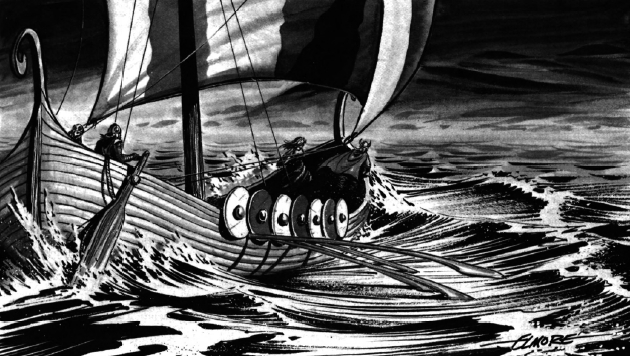
LORCA
SIZE: l
COST (1,000 taels): 43
FULL LENGTH (ft): 130
DECK LENGTH (ft): 110
BEAM (ft): 30
DRAFT (ft): 8
FREEBOARD (ft): 4
TONNAGE: 500
NO. MASTS: 4
NO. FULL DECKS: 1
NO. PARTIAL DECKS: 2
SIZE OF DECKHOUSE: 16 x 12
NO. PUMPS: 0
NO. OF SAMPANS: 2
BASE SPEED (SAIL) ("): 27
MANEUVERABILITY (SAIL): 8
DEFENSIVE POINTS:
HULL: 60
EACH MAST: 15
RIGGING & SAIL: 27
ARTILLERY ENGINES:
BALLISTAS:
LIGHT MANGONELS:
MEDIUM MANGONELS:
HEAVY MANGONELS:
CREW: 20:
MAX. ADD.: 38
SIZE:
COST (1,000 gp):
FULL LENGTH (ft):
DECK LENGTH (ft):
BEAM (ft):
DRAFT (ft):
FREEBOARD (ft):
TONNAGE:
NO. MASTS:
NO. FULL DECKS:
NO. PARTIAL DECKS:
NO. PUMPS:
NO. BOATS:
BASE SPEED ("):
MANEUVERABILITY (SAIL):
DEFENSIVE POINTS:
HULL:
EACH MAST:
RIGGING & SAIL:
ARTILLERY ENGINES:
BALLISTAS:
LIGHT MANGONELS:
MEDIUM MANGONELS:
HEAVY MANGONELS:
COMPLEMENT:
COMM. OFF.:
PETTY OFF. I:
PETTY OFF. II:
MATES I.:
MATES II.:
SAILORS:
MAXIMUM ADD.:
SIZE:
COST (1,000 taels):
FULL LENGTH (ft):
DECK LENGTH (ft):
BEAM (ft):
DRAFT (ft):
FREEBOARD (ft):
TONNAGE:
NO. MASTS:
NO. FULL DECKS:
NO. PARTIAL DECKS:
NO. PUMPS:
NO. BOATS:
BASE SPEED ("):
MANEUVERABILITY (SAIL):
DEFENSIVE POINTS:
HULL:
EACH MAST:
RIGGING & SAIL:
ARTILLERY ENGINES:
BALLISTAS:
LIGHT MANGONELS:
MEDIUM MANGONELS:
HEAVY MANGONELS:
COMPLEMENT:
COMM. OFF.:
PETTY OFF. I:
PETTY OFF. II:
MATES I.:
MATES II.:
SAILORS:
MAXIMUM ADD.:
RAM?:
OAR LENGTH:
NO. OF BANKS:
OARS/BANK:
LOWER:
MID:
UPPER:
TOTAL OARS:
ROWERS/OAR:
TOTAL ROWERS:
OAR SPEED:
NORMAL:
BATTLE:
SPRINT:
MANEUVERABILITY (OARS):
A good boat for N4 Treasure Hunt, from
Dragon #116